Applications of Smart Helmet in Applied Sciences: A Systematic Review
Abstract
1. Introduction
2. Research Methodology
- (1)
- Research questions were defined to conduct a systematic review of smart helmets.
- (2)
- A search method was designed to identify academic research articles related to the research questions.
- (3)
- Selection criteria were set to distinguish between articles related to the research questions and those not related to them.
- (4)
- The selected articles were analyzed, and the results were integrated.
- (5)
- The results were summarized and reported to provide answers to the research questions.
2.1. Definition of Research Questions
- RQ1: How is the trend of publications related to smart helmet research by year and source?
- RQ2: In which fields has the smart helmet research been mainly conducted?
- RQ3: What kinds of sensor have been mainly used for smart helmet applications?
- RQ4: What types of microcontroller have been primarily used to develop smart helmets?
- RQ5: What kinds of wireless communication technology have been mainly used to connect smart helmet with other devices?
2.2. Literature Search and Selection
2.3. Data Analysis and Outline of Results
3. Results
3.1. Current Status of Publications Related to Smart Helmet Research by Year and Source
3.2. Application Fields of Smart Helmet Research
3.3. Sensors Used for Smart Helmet Applications
3.4. Types of Microcontroller Used in Smart Helmets
- -
- Chip modular concept unit (MCU): a single computer chip designed for embedded applications (e.g., PIC 18F8720) [110]
- -
- Single-board MCU: a microcontroller built onto a single printed circuit board (e.g., Arduino) [111]
- -
- Single-board computer: a complete computer built on a single circuit board, with microprocessor(s), memory, input/output, and other features required for a functional computer (e.g., Raspberry Pi) [112]
- -
- Smart device: an electronic device, generally connected to other devices or networks by means of different wireless protocols that can operate to some extent interactively and autonomously (e.g., smartphone) [113]
3.5. Types of Wireless Communication Technology Used in Smart Helmet Studies
4. Discussion
- Advantages of smart helmet
- Smart helmet is an intelligent and reliable wearable device with low costs of development and operation.
- Smart helmets can contribute to improving the safety of motorcyclists and workers by immediately detecting accidents and supporting rescue requests in emergency situations.
- Smart helmets are highly expandable and can be used in other applications by adding or removing sensors as needed.
- Smart helmets can be combined with wireless communication technology to secure the always-on connectivity of a device. Therefore, data can be acquired in real time from sensors attached to the helmet and transmitted to a cloud server for analysis.
- Limitations of smart helmet
- Some sensors, such as cameras and global positioning systems attached to smart helmets have potential elements of privacy invasion. To date, there has been insufficient research on the security and privacy of data collected by smart helmets through sensors.
- Smart helmets mainly use inexpensive and lightweight sensors. Therefore, there is a possibility that the sensor malfunctions frequently, and a false alarm occurs.
- Various sensors can be attached to smart helmets, as needed; however, this can increase the helmet’s weight and make it uncomfortable to wear. Moreover, attaching a large battery to power a smart helmet increases the load and can be dangerous to humans. Until now, little research has been conducted on the discomfort and health that people feel when wearing a smart helmet.
- (1)
- Power consumption and battery life: As can be seen from the review results, power consumption is expected to increase as various sensors are being added to the smart helmet. Frequent charging and battery replacement can reduce the utility of the smart helmet. Therefore, there is a need for a study on how to extend the battery operating time of a smart helmet by using low-power sensors and microcontrollers.
- (2)
- Wearability: Smart helmets are relatively heavy compared to traditional helmets because a variety of sensors and microcontrollers are attached. Motorcyclists or field workers wearing heavy smart helmets may feel uncomfortable. In order for a smart helmet to provide its own functions as a wearable device, it is necessary to reduce the weight of the smart helmet by using lightweight materials and parts. Further research is required for this.
- (3)
- Human health and safety: Because a smart helmet is worn on a person’s head, research on the effect of the electromagnetic field emitted from a sensor or microcontroller on human health is required. In addition, it is necessary to consider the safety of the use of smart helmets in places where combustible gases may exist, such as underground mines and chemical facilities.
- (4)
- Durability: Workers wearing smart helmets often work in high humidity and dusty environments. Smart helmets developed to date often have microcontrollers and sensors exposed to the outside of the helmet, and can be vulnerable to high humidity and dust. Research is needed to increase the durability of smart helmets so that smart helmets can provide functions even in harsh working environments.
- (5)
- Accuracy: The sensors attached to the smart helmet should be small in size, lightweight, and low power consumption. Sensors that can meet these conditions at the same time may not have high measurement accuracy. Therefore, there is a need for research on a method that can improve the accuracy of measurement results while satisfying the sensor condition of a smart helmet.
- (6)
- Privacy and data security: The smart helmet collects various information such as photos and videos according to the attached sensors. However, this collection of information can sometimes cause privacy concerns. In addition, there is a possibility of unauthorized users hacking the information in the stage of transmitting the data collected from the smart helmet. Therefore, the privacy and data security issues associated with the use of smart helmets are challenges that require continuous research.
- (7)
- International standards: There are currently no international standards for smart helmets. In order to activate the development and distribution of smart helmets, it is necessary to consult and finance international standards for smart helmet specifications, functions, sensors, microcontrollers, wireless communication technology, etc.
5. Conclusions
- (1)
- The number of studies on smart helmets has increased rapidly since 2018. In the last three years (2018–2020), these studies accounted for 74.8% of the total number of studies. Therefore, it can be said that the research on smart helmets has been receiving considerable attention, and it is expected to be expanded further in the future.
- (2)
- Studies on smart helmets can be divided into two categories (i.e., motorcyclists and workers) depending on the user. Among these, the application of smart helmets to motorcyclists accounts for 79%. Because helmets are necessary items that should be worn by motorcyclists, smart helmet studies have attracted relatively more attention in this field. Most smart helmets for motorcyclists provide functions for starting a motorcycle and rescue requests in emergency situations. To date, research on smart helmets for workers has been inadequate.
- (3)
- Among the various sensors used for developing smart helmets, those related to human health monitoring have been used the most, and the last three years (2018–2020) have seen the highest increase. Among them, sensors for detecting accidents, helmet wearing status, and alcohol were frequently used, accounting for 32%, 30%, and 27%, respectively. Note that the use of environmental monitoring sensors for harmful gas detection, image information acquisition, and temperature measurement, has rapidly increased since 2019.
- (4)
- Currently, the type of microcontroller primarily used for developing smart helmets is a single-board MCU, such as the Arduino board, which accounts for more than 50% of all microcontroller types. Although single-board computers such as the Raspberry Pi or smartphones are also being used to develop smart helmets, this number has not been so far.
- (5)
- To date, approximately 85% of smart helmets have been developed using wireless communication technologies, such as RF, Bluetooth, WiFi, and Zigbee. Among them, the use of RF and Bluetooth has been increasing rapidly since 2015, and they are the most commonly used technologies today, accounting for 38% and 34%, respectively.
Author Contributions
Funding
Institutional Review Board Statement
Informed Consent Statement
Data Availability Statement
Conflicts of Interest
References
- Wrzesińska, N. The use of smart glasses in healthcare—Review. MEDtube Sci. 2015, 3, 31–34. [Google Scholar]
- Choi, B.; Hwang, S.; Lee, S.H. What drives construction workers’ acceptance of wearable technologies in the workplace? Indoor localization and wearable health devices for occupational safety and health. Autom. Constr. 2017, 84, 31–41. [Google Scholar] [CrossRef]
- Audi Uses Wearables in Logistics. Available online: https://www.volkswagenag.com/en/news/2016/11/Audi_Wearables.html (accessed on 5 February 2018).
- TECHZONE360. Available online: http://www.techzone360.com/topics/techzone/articles/2016/06/27/422510-6-insurance-companies-investing-wearable-technology.htm# (accessed on 20 November 2017).
- Wright, R.; Keith, L. Wearable Technology: If the Tech Fits, Wear It. J. Electron. Resour. Med Libr. 2014, 11, 204–216. [Google Scholar] [CrossRef]
- Grand View Research. Available online: https://www.grandviewresearch.com/industry-analysis/smarthelmet-market (accessed on 7 October 2020).
- Singh, V.; Chandna, H.; Upadhyay, N. SmartPPM: An Internet of Things Based Smart helmet Design for Potholes and Air Pollution Monitoring. EAI Endorsed Trans. Internet Things 2019, 5, 1–9. [Google Scholar] [CrossRef]
- Wang, C.; Kim, Y.; Kim, D.G.; Lee, S.H.; Min, S.D. Smart helmet and Insole Sensors for Near Fall Incidence Recognition during Descent of Stairs. Appl. Sci. 2020, 10, 2262. [Google Scholar] [CrossRef]
- Mohammed, M.N.; Syamsudin, H.; Al-Zubaidi, S.; Yusuf, E. Novel Covid-19 Detection and Diagnosis System Using Iot Based Smart Helmet. Int. J. Psychosoc. Rehabil. 2020, 24, 2296–2303. [Google Scholar]
- Rasli, M.K.A.; Madzhi, N.K.; Johari, J. Smart Helmet with Sensors for Accident Prevention. In Proceedings of the 2013 International Conference on Electrical, Electronics and System Engineering (ICEESE), Kuala Lumpur, Malaysia, 4–5 December 2013; pp. 21–26. [Google Scholar] [CrossRef]
- Vijayan, S.; Govind, V.T.; Mathews, M.; Surendran, S. Alcohol Detection Using Smart Helmet System. Int. J. Emerg. Technol. Comput. Sci. Electron. 2014, 8, 190–195. [Google Scholar]
- Agarwal, N.; Singh, A.K.; Singh, P.P.; Sahani, R. Smart helmet. Int. Res. J. Eng. Technol. 2015, 2, 19–22. [Google Scholar]
- Gautam, A.S.; Dubey, G.K.; Mishra, M.; Prabhat, M. Smart helmet System. J. Emerg. Technol. Innov. Res. 2015, 2, 1165–1168. [Google Scholar]
- Melcher, V.; Diederichs, F.; Maestre, R.; Hofmann, C.; Nacenta, J.-M.; van Gent, J.; Kusić, D.; Žagar, B. Smart Vital Signs and Accident Monitoring System for Motorcyclists Embedded in Helmets and Garments for Advanced ECall Emergency Assistance and Health Analysis Monitoring. Procedia Manuf. 2015, 3, 3208–3213. [Google Scholar] [CrossRef]
- Chandran, S.; Chandrasekar, S.; Elizabeth, N.E. Konnect: An Internet of Things (IoT) Based Smart helmet for Accident Detection and Notification. In Proceedings of the 2016 IEEE Annual India Conference (INDICON), Bangalore, India, 16–18 December 2016; pp. 1–4. [Google Scholar] [CrossRef]
- Magno, M.; D’Aloia, A.; Polonelli, T.; Spadaro, L.; Benini, L. SHelmet: An Intelligent Self-Sustaining Multi Sensors Smart helmet for Bikers. In Sensor Systems and Software; Lecture Notes of the Institute for Computer Sciences, Social Informatics and Telecommunications Engineering; Magno, M., Ferrero, F., Bilas, V., Eds.; Springer International Publishing: Cham, Switzerland, 2017; Volume 205, pp. 55–67. [Google Scholar] [CrossRef]
- Nikharge, B.J.; Poojary, M.M.; Pooja, T. Smart Helmet—Intelligent Safety for Motorcyclist Using Raspberry Pi and Open Cv. Int. Res. J. Eng. Technol. 2016, 3, 589–593. [Google Scholar]
- Jadhawar, M.; Kandepalli, G.; Kohade, A.; Komati, R. Smart Helmet Safety System Using Atmega 32. Int. J. Res. Eng. Technol. 2016, 5, 287–289. [Google Scholar]
- Kim, J.; Koo, S.E.; Lim, J.Y.; Jin, M.W.; Choi, J.M. Smart Helmet. In Proceedings of the ICCC 2016 International Conference on Convergence Content, Kunsan, Korea, 22–27 May 2016; pp. 357–358. [Google Scholar]
- Kumar, S.; Srikrishnan, A.; Ravi, S. Cloud Incorporated Smart helmet Integrated with Two-Wheeler Communication Setup. Int. J. Control. Theory Appl. 2016, 9, 251–261. [Google Scholar]
- Vashisth, R.; Gupta, S.; Jain, A.; Gupta, S.; Sahil; Rana, P. Implementation and Analysis of Smart helmet. In Proceedings of the 2017 4th International Conference on Signal Processing, Computing and Control (ISPCC), Solan, India, 21–23 September 2017; pp. 111–117. [Google Scholar] [CrossRef]
- Varade, A.; Gajbhiye, N.; Panchbhai, A.V.V. Smart Helmet Using GSM and GPS. Int. Res. J. Eng. Technol. 2017, 04, 1662–1667. [Google Scholar]
- Rajput, A.; Saxena, A.; Agarwal, A.; Bhatia, A.; Mishra, A. Smart helmet with Rider Safety System. Int. J. Innov. Emerg. Res. Eng. 2017, 4, 52–60. [Google Scholar]
- Patel, M.V.A.; Mishra, M.A.; Hiten, M.R.; Prajapati, M.K. Smart helmet. Int. Res. J. Eng. Technol. 2017, 4, 7–10. [Google Scholar]
- Muthiah, M.; Aswin Natesh, V.; Sathiendran, R.K. Smart helmets for Automatic Control of Headlamps. In Proceedings of the 2015 International Conference on Smart Sensors and Systems (IC-SSS), Bangalore, India, 21–23 December 2015; pp. 1–4. [Google Scholar] [CrossRef]
- Ahuja, P.; Bhavsar, K. Microcontroller Based Smart helmet Using GSM & GPRS. In Proceedings of the 2018 2nd International Conference on Trends in Electronics and Informatics (ICOEI), Tirunelveli, India, 11–12 May 2018; pp. 1–9. [Google Scholar] [CrossRef]
- Godwani, P.D.; Dhokrat, A.U.; Kubde, G.D.; Kumbhar, R.R.; Mahajan, R.G. Smart helmet for Accident Detection and Navigation. Int. J. Creat. Res. Thoughts 2018, 6, 788–792. [Google Scholar]
- Parameshwari, P.; Pujari, V.; Gadgay, B. Smart Helmet for Accident Prevention. Int. Res. J. Eng. Technol. 2018, 5, 368–370. [Google Scholar]
- Biswas, J.R.; Kachroo, S.; Chopra, P.; Sharma, S. Development of an App Enabled Smart helmet for Real Time Detection and Reporting of Accidents. In Proceedings of the 2018 7th International Conference on Reliability, Infocom Technologies and Optimization (Trends and Future Directions (ICRITO), Noida, India, 29–31 August 2018; pp. 703–708. [Google Scholar] [CrossRef]
- Budiman, A.R.; Sudiharto, D.W.; Brotoharsono, T. The Prototype of Smart helmet with Safety Riding Notification for Motorcycle Rider. In Proceedings of the 2018 3rd International Conference on Information Technology, Information System and Electrical Engineering (ICITISEE), Yogyakarta, Indonesia, 13–14 November 2018; pp. 362–367. [Google Scholar] [CrossRef]
- Uniyal, M.; Rawat, H.; Srivastava, M.; Srivastava, V.K. IOT Based Smart helmet System with Data Log System. In Proceedings of the 2018 International Conference on Advances in Computing, Communication Control and Networking (ICACCCN), Greater Noida, India, 12–13 October 2018; pp. 28–31. [Google Scholar] [CrossRef]
- Paulchamy, D.B.; Sundhararajan, C.; Xavier, R.; Ramkumar, A.; Vigneshwar, D. Design of Smart helmet and Bike Management System. Asian J. Appl. Sci. Technol. 2018, 2, 207–211. [Google Scholar]
- Souza, A.D.; Maliyackal, S.S. Helmet Integrated Bike Ignition Using Arduino. In Proceedings of the 4th International Conference on Energy Efficient Technologies for Sustainability–ICEETS’18, Tamil Nadu, India, 5–7 April 2018; pp. 1–5. [Google Scholar]
- Nanda, S.; Joshi, H.; Khairnar, S. An IOT Based Smart System for Accident Prevention and Detection. In Proceedings of the 2018 Fourth International Conference on Computing Communication Control and Automation (ICCUBEA), Pune, India, 16–18 August 2018; pp. 1–6. [Google Scholar] [CrossRef]
- Deva Kumar, S.V.S.V.P.; Akashe, S.; Kumar, V. Advanced Control of Switching Ignition by Smart helmet. Int. J. Image Graph. Signal Process. 2018, 10, 34–42. [Google Scholar] [CrossRef]
- Sumamah, M.; Faiz, M.; Tyagi, A. Smart helmet kit. Int. Res. J. Eng. Technol. 2018, 5, 3018–3020. [Google Scholar]
- Shabbeer, S.A.; Meleet, M. Smart helmet for Accident Detection and Notification. In Proceedings of the 2017 2nd International Conference on Computational Systems and Information Technology for Sustainable Solution (CSITSS), Bengaluru, India, 21–23 December 2017; pp. 1–5. [Google Scholar] [CrossRef]
- Gudavalli, D.K.P.; Rani, B.S.; Sagar, C.V. Helmet Operated Smart E-Bike. In Proceedings of the 2017 IEEE International Conference on Intelligent Techniques in Control, Optimization and Signal Processing (INCOS), Srivilliputhur, India, 23–25 March 2017; pp. 1–5. [Google Scholar] [CrossRef]
- Tapadar, S.; Ray, S.; Saha, H.N.; Saha, A.K.; Karlose, R. Accident and Alcohol Detection in Bluetooth Enabled Smart helmets for Motorbikes. In Proceedings of the 2018 IEEE 8th Annual Computing and Communication Workshop and Conference (CCWC), Las Vegas, NV, USA, 8–10 January 2018; pp. 584–590. [Google Scholar] [CrossRef]
- Premalatha, K.; Nandhini, J.J. Safeguarding Two Wheeler User’s Lives Using Smart helmet. Int. J. Innov. Technol. Explor. Eng. 2018, 8, 417–419. [Google Scholar]
- Dhulavvagol, P.M.; Shet, R.; Nashipudi, P.; Meti, A.S.; Ganiger, R. Smart helmet with Cloud GPS GSM Technology for Accident and Alcohol Detection. In Cognitive Computing and Information Processing; Communications in Computer and Information Science; Nagabhushan, T.N., Aradhya, V.N.M., Jagadeesh, P., Shukla, S.M.L.C., Eds.; Springer: Singapore, 2018; Volume 801, pp. 346–357. [Google Scholar] [CrossRef]
- Joshi, S.B.; Joshi, A.S. A Novel Method for Safety of Two Wheeler Using Microcontroller. Int. J. Adv. Res. Innov. Ideas Educ. 2019, 5, 1439–1442. [Google Scholar]
- Namayala, P.P. Development of Smart helmet Motor Cycles’ Embedded System. Int. J. Eng. Res. Adv. Technol. 2019, 5, 75–84. [Google Scholar] [CrossRef]
- Wong, K.I.; Chen, Y.-C.; Lee, T.-C.; Wang, S.-M. Head Motion Recognition Using a Smart helmet for Motorcycle Riders. In Proceedings of the 2019 International Conference on Machine Learning and Cybernetics (ICMLC), Kobe, Japan, 7–10 July 2019; pp. 1–7. [Google Scholar] [CrossRef]
- Kinage, V.; Patil, P. IoT Based Intelligent System for Vehicle Accident Prevention And Detection At Real Time. In Proceedings of the 2019 IoThird International conference on I-SMACT in Social, Mobile, Analytics and Cloud (I-SMAC), Palladam, India, 12–14 December 2019; pp. 409–413. [Google Scholar] [CrossRef]
- Swathi, S.J.; Raj, S.; Devaraj, D. Microcontroller and Sensor Based Smart Biking System for Driver’s Safety. In Proceedings of the 2019 IEEE International Conference on Intelligent Techniques in Control, Optimization and Signal Processing (INCOS), Tamilnadu, India, 11–13 April 2019; pp. 1–5. [Google Scholar] [CrossRef]
- Reddy, D.D.V.; Suresh, V.; Hemalatha, T. Smart helmet and Bike Management System. J. Gujarat Res. Soc. 2019, 21, 303–311. [Google Scholar]
- Shravya, K.; Mandapati, Y.; Keerthi, D.; Harika, K.; Senapati, R.K. Smart helmet for Safe Driving. E3S Web Conf. 2019, 87, 1–4. [Google Scholar] [CrossRef]
- Kanimozhi, L.; Sambasivam, R.; Pragathi, M.; Ranjith, M. Smart helmet with Accident Avoidance System. Cikitusi J. Multidiscip. Res. 2019, 6, 1–7. [Google Scholar]
- Patil, M.S.A.; Wagh, M.V.R.; Ganpatre, M.V.J. IOT Based Smart helmet For Accident Detection. Resincap J. Sci. Eng. 2019, 3, 455–458. [Google Scholar]
- Jesudoss, A.; Vybhavi, R.; Anusha, B. Design of Smart helmet for Accident Avoidance. In Proceedings of the 2019 International Conference on Communication and Signal Processing (ICCSP), Chennai, India, 4–6 April 2019; pp. 0774–0778. [Google Scholar] [CrossRef]
- Kabilan, M.; Monish, S.; Siamala Devi, D.S. Accident Detection System Based on Internet of Things (IoT)-Smart helmet. Int. J. Eng. Res. Adv. Technol. 2019, 5, 154–157. [Google Scholar]
- Ashwin, M.; Yashwanth Gowda, S. Smart helmet Using GPS and GSM Modem. Int. J. Eng. Res. Adv. Technol. 2019, 8, 3005–3008. [Google Scholar] [CrossRef]
- Chen, Y.-R.; Tsai, C.-M.; Wong, K.-I.; Lee, T.-C.; Loh, C.-H.; Ying, J.-C.; Chen, Y.-C. Motorcyclists’ Head Motions Recognition by Using the Smart helmet with Low Sampling Rate. In Proceedings of the 2019 Twelfth International Conference on Ubi-Media Computing (Ubi-Media), Bali, Indonesia, 5–8 August 2019; pp. 157–163. [Google Scholar] [CrossRef]
- Gupta, S.; Sharma, K.; Salvekar, N.; Gajra, A. Implementation of Alcohol and Collision Sensors in a Smart helmet. In Proceedings of the 2019 Conception of smart iol helmet in smart factory (ICNTE), Navi Mumbai, India, 4–5 January 2019; pp. 1–5. [Google Scholar] [CrossRef]
- Priya, V.; Dhanasekar, J.; Vasumathi, G. Smart helmet Using PIC Controller. Int. J. Eng. Res. Adv. Technol. 2019, 8, 750–752. [Google Scholar] [CrossRef]
- Vijayakumar, D.; Ramesh, G.; Jayabalan, C.; Palani, S.; Selvam, M. Micro Controller Based Smart helmet by Ir Motion Sensors. Int. J. Eng. Res. Adv. Technol. 2019, 8, 1850–1853. [Google Scholar] [CrossRef]
- Divyasudha, N.; Arulmozhivarman, P.; Rajkmumar, E.R. Analysis of Smart helmets and Designing an IoT Based Smart helmet: A Cost Effective Solution for Riders. In Proceedings of the 2019 1st International Conference on Innovations in Information and Communication Technology (ICIICT), Chennai, India, 25–26 April 2019; pp. 1–4. [Google Scholar] [CrossRef]
- Mhatre, K.; Nandwadekar, R.; Patil, A.; Shinde, R.; Kamble, P. Smart helmet With Intercom Feature. SSRN J. 2020, 1–5. [Google Scholar] [CrossRef]
- Lakshmanachari, S.; Ramya, M. Smart helmet System for Identification of Road Accident Using Internet of Things. Int. J. Adv. Sci. Technol. 2020, 29, 1070–1076. [Google Scholar]
- Merlin, R.; Pranay, R.D. Smart helmet system. TEST Eng. Manag. 2020, 83, 1991–1995. [Google Scholar]
- Chidambarathanu, G.V.; Farzana, D.F.; Gowrishankar, J. Accidents Preventing Smart helmet Using EEG Sensor. TEST Eng. Manag. 2020, 82, 2541–2547. [Google Scholar]
- Santhanakrishnan, C.; Sharma, D.; Vashistha, A. Smart helmet for Rider (SHR) and Accident Detection Using IOT. Int. J. Adv. Sci. Technol. 2020, 29, 50–57. [Google Scholar]
- Sai Kumar, M.; Aruna, M. Third Eye Two Wheeler: Accident and Malt Detection in Bluetooth Enabled Smart helmets with Load Monitoring for Motorbikes. TEST Eng. Manag. 2020, 82, 6696–6701. [Google Scholar]
- Suman, A.; Parashar, A.; Shukla, A.; Shobha, K.R. Aagaahi—A Smart helmet. In Proceedings of the 2020 IEEE International Conference on Electronics, Computing and Communication Technologies (CONECCT), Bangalore, India, 2–4 July 2020; pp. 1–6. [Google Scholar] [CrossRef]
- Ahmed, S.U.; Uddin, R.; Affan, M. Intelligent Gadget for Accident Prevention: Smart helmet. In Proceedings of the 2020 International Conference on Computing and Information Technology (ICCIT-1441), Tabuk, Saudi Arabia, 9–10 September 2020; pp. 1–4. [Google Scholar] [CrossRef]
- Dubey, S.; Meghana, K.; Likhitha, M.; Gupta, K.; Balaji, R. An Experimental Study on Advanced Lane Changing Signal Assist Technology with Smart helmet. Mater. Today Proc. 2020, 33, 4771–4776. [Google Scholar] [CrossRef]
- Lokeshwaran, M.; Nikhit Mathew, S.P.; Joshuva, A. Raphael—The Smart helmet. In Proceedings of the 2020 International Conference on Wireless Comunications Signal Processing and Networking (WiSPNET), Chennai, India, 19–21 March 2020; pp. 48–51. [Google Scholar]
- Rahman, M.A.; Ahsanuzzaman, S.M.; Rahman, I.; Ahmed, T.; Ahsan, A. IoT Based Smart helmet and Accident Identification System. In Proceedings of the 2020 IEEE Region 10 Symposium (TENSYMP), Dhaka, Bangladesh, 5–7 June 2020; pp. 14–17. [Google Scholar] [CrossRef]
- Faikul, U.; Hairil, B.; Ach, D. Smart helmet Control System Using Heart Pulse Indicator. In Proceedings of the 2020 International Conference on Science and Technology, Surabaya, Indonesia, 3 November 2020; pp. 1–8. [Google Scholar]
- Rao, P.K.; Sai, P.T.; Kumar, N.V.; Sagar, S.Y.V. Design and Implementation of Smart helmet Using IoT. In Proceedings of the 2020 International Confernce of Advance Research and Innovation, Meerut, India, 19 January 2020; pp. 323–325. [Google Scholar]
- Oviyaa, M.; Renvitha, P.; Swathika, R.; Paul, I.J.L.; Sasirekha, S. Arduino Based Real Time Drowsiness and Fatigue Detection for Bikers Using Helmet. In Proceedings of the 2020 2nd International Conference on Innovative Mechanisms for Industry Applications (ICIMIA), Bangalore, India, 5–7 March 2020; pp. 573–577. [Google Scholar] [CrossRef]
- Shahare, B.; Chawde, S.; Gudafwar, R.; Pal, H.; Bobade, P. Iot Based Smart Motor Cycle Helmet. Int. J. Progress. Res. Sci. Eng. 2020, 1, 107–109. [Google Scholar]
- Ashwini, S.S.; Udupa, N.G.; Sweta, N.; Alam, M.S. A Smart Helmet on IoT Technology for Safety and Accident Detection. Int. J. R D Eng. Sci. Manag. 2020, 3, 99–102. [Google Scholar]
- Jayasinghe, S.; Arachchige, U. A Smart helmet with a built-in drowsiness and alcohol detection system. J. Res. Technol. Eng. 2020, 1, 76–81. [Google Scholar]
- Aravinda, N.L.; Jabirullah, M.; DubasiKirtana. An Intelligent Helmet System Using IoT and Raspberry Pi. IOP Conf. Ser. Mater. Sci. Eng. 2020, 981, 1–7. [Google Scholar] [CrossRef]
- MohanaRoopa, D.Y.; Soujanya, N.; Vaishnavi, V.S.; Vardhan, U.V. An IOT Based Smart helmet for Accident Detection and Notification. J. Interdiscip. Cycle Res. 2020, 7, 1–7. [Google Scholar]
- Pothirajan, M.G.; Mary, M.J.V. IOT Based Vehicle Monitoring Using Smart Helmet. Alochana Chakra J. 2020, 15, 671–674. [Google Scholar]
- Swarna, V.; Deepika, P.; Zaheer, S.; Raj, S.M.; Rao, E.K. Smart helmet for Rider’s Safety. J. Res. Sci. Eng. Manag. 2020, 6, 13–17. [Google Scholar]
- Parakkal, S.A.; Avhad, P.V.; Dhole, V.; Raikar, Y.; Gite, B.B. Smartphone Integrated Smart helmet for Real-Time Detection, Prevention and Reporting of Accidents. Bull. Monum. 2020, 21, 41–45. [Google Scholar]
- Kumar Kar, S.; Anshuman, D.A.; Raj, H.; Pall Singh, P. New Design and Fabrication of Smart helmet. IOP Conf. Ser. Mater. Sci. Eng. 2018, 402, 1–10. [Google Scholar] [CrossRef]
- Rahman, A.; Abdurohman, M.; Putrada, A.G. Indicator Warning Refined Fuel Oil in A Motorcycle With Fuzzy Logic and Sound Navigaiotn Through Smart helmet. In Proceedings of the 2019 International Symposium on Electronics and Smart Devices (ISESD), Badung, Indonesia, 8–9 October 2019; pp. 1–5. [Google Scholar] [CrossRef]
- Jadhav, A.; Rajput, S.; Baburao, K.V.; Rajput, D.D.S. Smart helmet Using Natural Language Processing, Head Mounted Display and Solar Panel. Int. J. Sci. Technol. Res. 2019, 8, 331–527. [Google Scholar]
- Youssef, A.; Colon, J.; Mantzios, K.; Gkiata, P.; Mayor, T.; Flouris, A.; De Bruyne, G.; Aerts, J.-M. Towards Model-Based Online Monitoring of Cyclist’s Head Thermal Comfort: Smart helmet Concept and Prototype. Appl. Sci. 2019, 9, 3170. [Google Scholar] [CrossRef]
- Rao, S. Voice Controlled Wiper for Smart helmets. Int. J. Innov. Technol. Explor. Eng. 2019, 8, 2086–2089. [Google Scholar] [CrossRef]
- Kanetkar, S.; Rathore, A.; Maheshwari, K.; Dubey, P.; Saxena, A. Smart helmet Wiper. In Proceedings of the 2020 IEEE International Students’ Conference on Electrical, Electronics and Computer Science (SCEECS), Bhopal, India, 22–23 February 2020; pp. 1–4. [Google Scholar] [CrossRef]
- Aatif, M.K.A.; Manoj, A. Smart helmet Based on IoT Technology. Int. J. Res. Appl. Sci. Eng. Technol. 2017, 5, 409–413. [Google Scholar]
- Ajay, A.; Vishnu, G.; Kishoreswaminathan, V.; Vishwanth, V.; Srinivasan, K.; Jeevanantham, S. Accidental Identification and Navigation System in Helmet. In Proceedings of the 2017 International Conference on Nextgen Electronic Technologies: Silicon to Software (ICNETS2), Chennai, India, 23–25 March 2017; pp. 202–204. [Google Scholar] [CrossRef]
- Kumar, A.; Manjunath, S.S.; Monish, R.; Ramya, S. The Intercom Enabled Helmet. Int. Res. J. Eng. Technol. 2019, 6, 3986–3988. [Google Scholar]
- Qiang, C.; Ji-ping, S.; Zhe, Z.; Fan, Z. ZigBee Based Intelligent Helmet for Coal Miners. In Proceedings of the 2009 WRI World Congress on Computer Science and Information Engineering, Los Angeles, CA, USA, 31 March–2 April 2009; pp. 433–435. [Google Scholar] [CrossRef]
- Shabina, S. Smart helmet Using RF and WSN Technology for Underground Mines Safety. In Proceedings of the 2014 International Conference on Intelligent Computing Applications, Coimbatore, India, 6–7 March 2014; pp. 305–309. [Google Scholar] [CrossRef]
- Behr, C.J.; Kumar, A.; Hancke, G.P. A Smart helmet for Air Quality and Hazardous Event Detection for the Mining Industry. In Proceedings of the 2016 IEEE International Conference on Industrial Technology (ICIT), Taipei, Taiwan, 14–17 March 2016; pp. 2026–2031. [Google Scholar] [CrossRef]
- Hazarika, P. Implementation of Smart Safety Helmet for Coal Mine Workers. In Proceedings of the 2016 IEEE 1st International Conference on Power Electronics, Intelligent Control and Energy Systems (ICPEICES), Delhi, India, 4–6 July 2016; pp. 1–3. [Google Scholar] [CrossRef]
- Sharma, M.; Maity, T. Low Cost Low Power Smart helmet for Real-Time Remote Underground Mine Environment Monitoring. Wirel. Pers Commun. 2018, 102, 149–162. [Google Scholar] [CrossRef]
- Revindran, R.; Vijayaraghavan, H.; Huang, M.-Y. Smart helmets for Safety in Mining Industry. In Proceedings of the 2018 International Conference on Advances in Computing, Communications and Informatics (ICACCI), Bangalore, India, 19–22 September 2018; pp. 217–221. [Google Scholar] [CrossRef]
- Eldemerdash, T.; Abdulla, R.; Jayapal, V.; Nataraj, C.; Abbas, K. Iot Based Smart helmet for Mining Industry Application. Int. J. Adv. Sci. Technol. 2020, 29, 373–387. [Google Scholar]
- Sanjay, B.S.; Dilip, K.A.; Balasaheb, T.A.; KinnuKumar, S.; Saware, N.P. Smart helmet Using Zigbee. Int. J. Innov. Res. Technol. 2019, 6, 144–148. [Google Scholar]
- Charde, A.; Dehankar, B.; Ghaturle, S.; Bende, B.; Kitey, S. A Smart and Secured Helmet for Coal Mining Workers. J. Res. Appl. Sci. Eng. Technol. 2020, 8, 673–675. [Google Scholar] [CrossRef]
- Sujitha, S.; Loret, S.; Gethsy, M. IOT Based Smart Mine Safety System Using Arduino. Int. J. Comput. Sci. Mob. Comput. 2020, 9, 141–145. [Google Scholar]
- Pirkl, G.; Hevesi, P.; Amarislanov, O.; Lukowicz, P. Smart helmet for Construction Site Documentation and Work Support. In Proceedings of the 2016 ACM International Joint Conference on Pervasive and Ubiquitous Computing, Heidelberg, Germany, 12–16 September 2016; pp. 349–352. [Google Scholar] [CrossRef]
- Lee, A.; Moon, J.; Min, S.D.; Sung, N.-J.; Hong, M. Safety Analysis System Using Smart helmet. Internet Comput. Internet Things 2019, 503, 102–107. [Google Scholar]
- Li, P.; Meziane, R.; Otis, M.J.-D.; Ezzaidi, H.; Cardou, P. A Smart Safety Helmet Using IMU and EEG Sensors for Worker Fatigue Detection. In Proceedings of the 2014 IEEE International Symposium on Robotic and Sensors Environments (ROSE), Timisoara, Romania, 16–18 October 2014; pp. 55–60. [Google Scholar] [CrossRef]
- Dhingra, J.; Arora, G.; Bhatia, P.; Goel, C. Smart helmet with Inter-Communication System, Smart Reminder System and Panic Button for Emergencies. Int. J. Eng. Res. 2018, 7, 319–320. [Google Scholar]
- Aston, J.P.; Benko, N.; Truong, T.; Zaki, A.; Olsen, N.; Eshete, E.; Luttmer, N.G.; Coats, B.; Minor, M.A. Optimization of a Soft Robotic Bladder Array for Dissipating High Impact Loads: An Initial Study in Designing a Smart helmet. In Proceedings of the 2020 3rd IEEE International Conference on Soft Robotics (RoboSoft), New Haven, CT, USA, 15 May–15 July 2020; pp. 607–614. [Google Scholar] [CrossRef]
- Campero-Jurado, I.; Márquez-Sánchez, S.; Quintanar-Gómez, J.; Rodríguez, S.; Corchado, J.M. Smart helmet 5.0 for Industrial Internet of Things Using Artificial Intelligence. Sensors 2020, 20, 6241. [Google Scholar] [CrossRef] [PubMed]
- Shu, L.; Li, K.; Zen, J.; Li, X.; Sun, H.; Huo, Z.; Han, G. A Smart helmet for Network Level Early Warning in Large Scale Petrochemical Plants. In Proceedings of the 14th International Conference on Information Processing in Sensor Networks—IPSN ’15; ACM Press: Seattle, WA, USA, 2015; pp. 390–391. [Google Scholar] [CrossRef]
- Bisio, I.; Fedeli, A.; Lavagetto, F.; Pastorino, M.; Randazzo, A.; Sciarrone, A.; Tavanti, E. Mobile Smart helmet for Brain Stroke Early Detection through Neural Network-Based Signals Analysis. In Proceedings of the GLOBECOM 2017—2017 IEEE Global Communications Conference, Singapore, 4–8 December 2017; pp. 1–6. [Google Scholar] [CrossRef]
- Shahiduzzaman, K.M.; Hei, X.; Guo, C.; Cheng, W. Enhancing Fall Detection for Elderly with Smart helmet in a Cloud-Network-Edge Architecture. In Proceedings of the 2019 IEEE International Conference on Consumer Electronics—Taiwan (ICCE-TW), Yilan, Taiwan, 20–22 May 2019; pp. 1–2. [Google Scholar] [CrossRef]
- Jeong, M.; Lee, H.; Bae, M.; Shin, D.-B.; Lim, S.-H.; Lee, K.B. Development and Application of the Smart helmet for Disaster and Safety. In Proceedings of the 2018 International Conference on Information and Communication Technology Convergence (ICTC), Jeju, Korea, 17–19 October 2018; pp. 1084–1089. [Google Scholar] [CrossRef]
- Wikipedia. Microcontroller. Available online: https://en.wikipedia.org/wiki/Microcontroller (accessed on 25 February 2021).
- Wikipedia. Single-Board Microcontroller. Available online: https://en.wikipedia.org/wiki/Single-board_microcontroller (accessed on 25 February 2021).
- Wikipedia. Single-Board Computer. Available online: https://en.wikipedia.org/wiki/Single-board_computer#Types,_standards (accessed on 25 February 2021).
- Wikipedia. Smart Device. Available online: https://en.wikipedia.org/wiki/Smart_device (accessed on 25 February 2021).
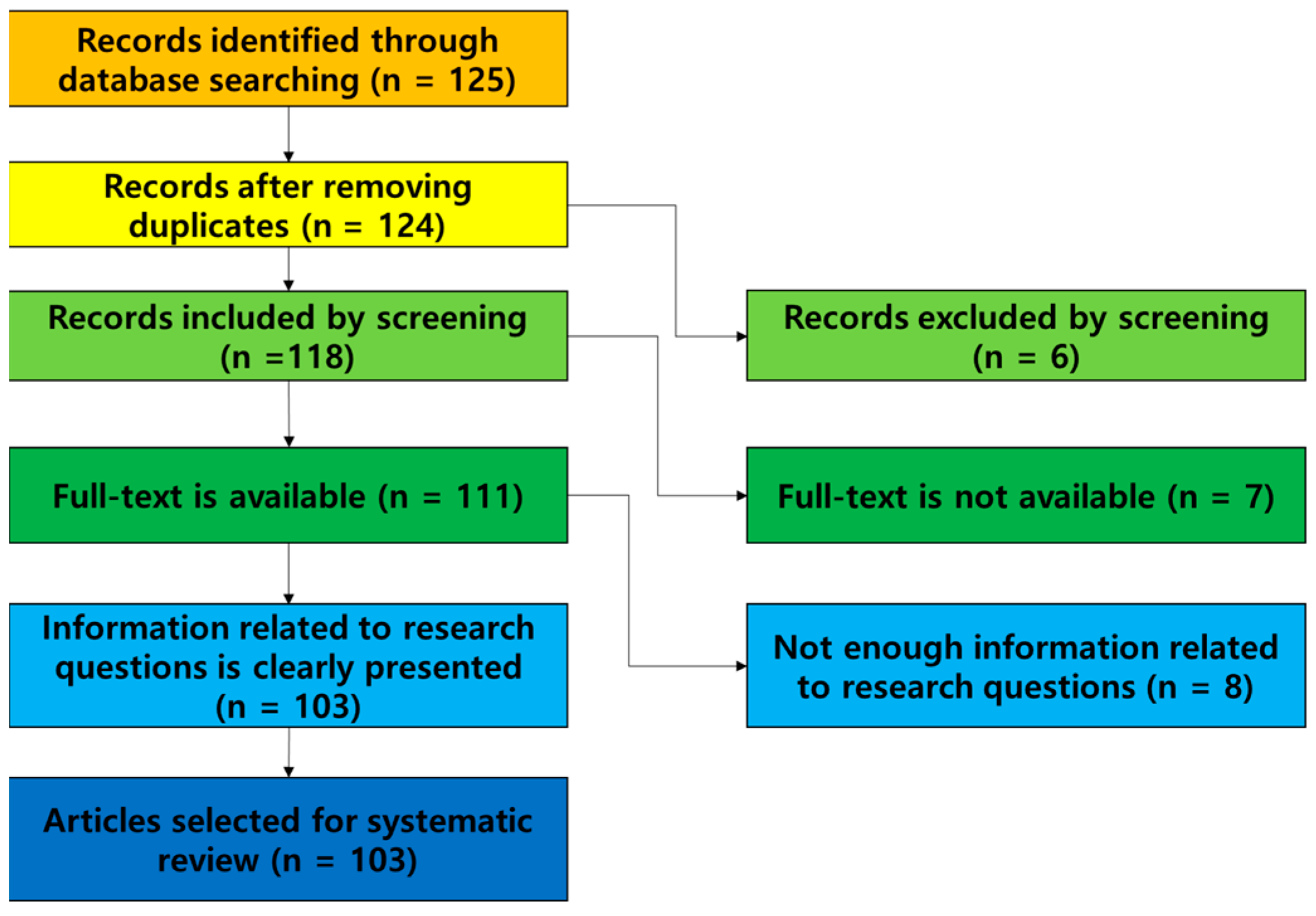
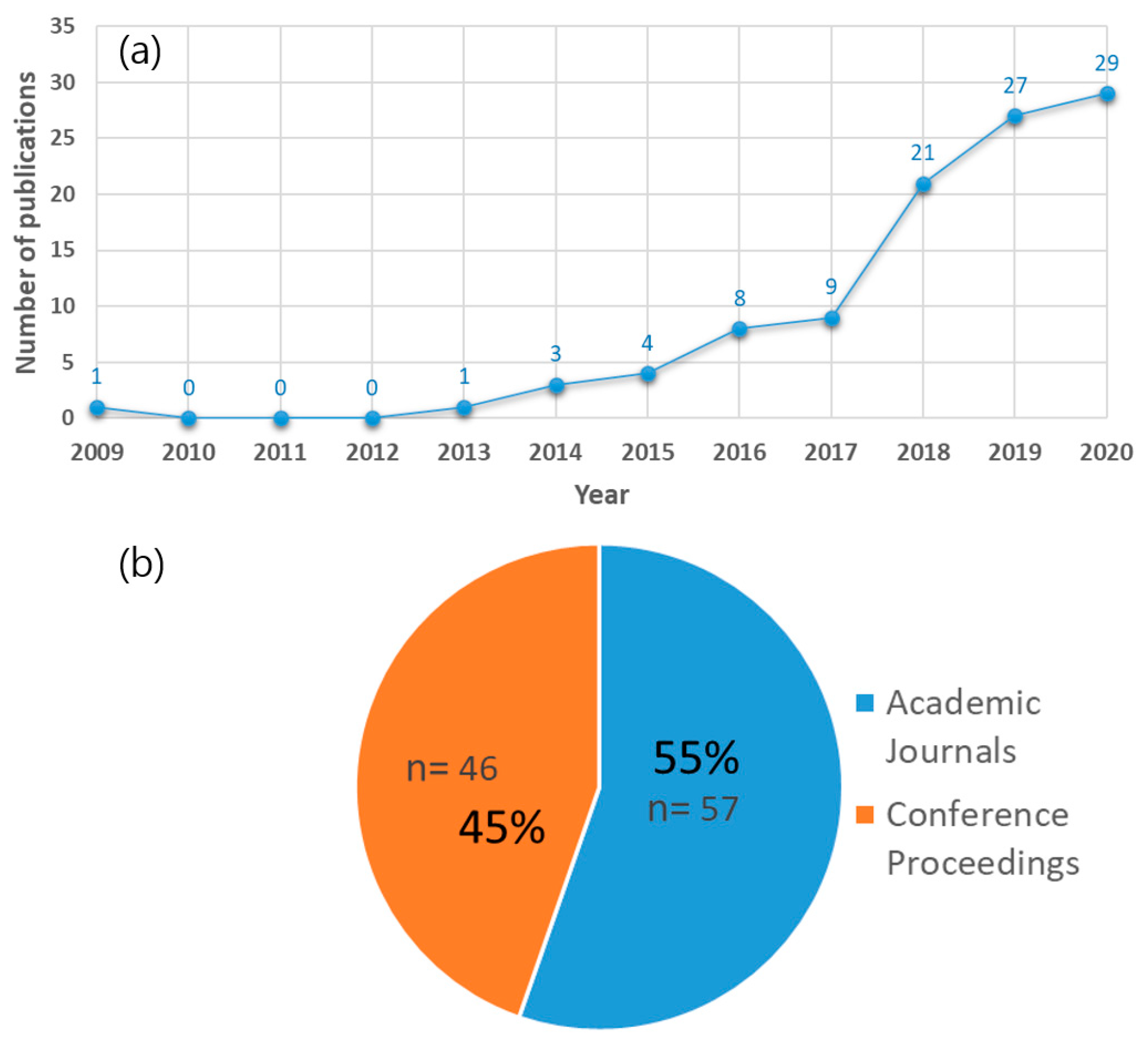
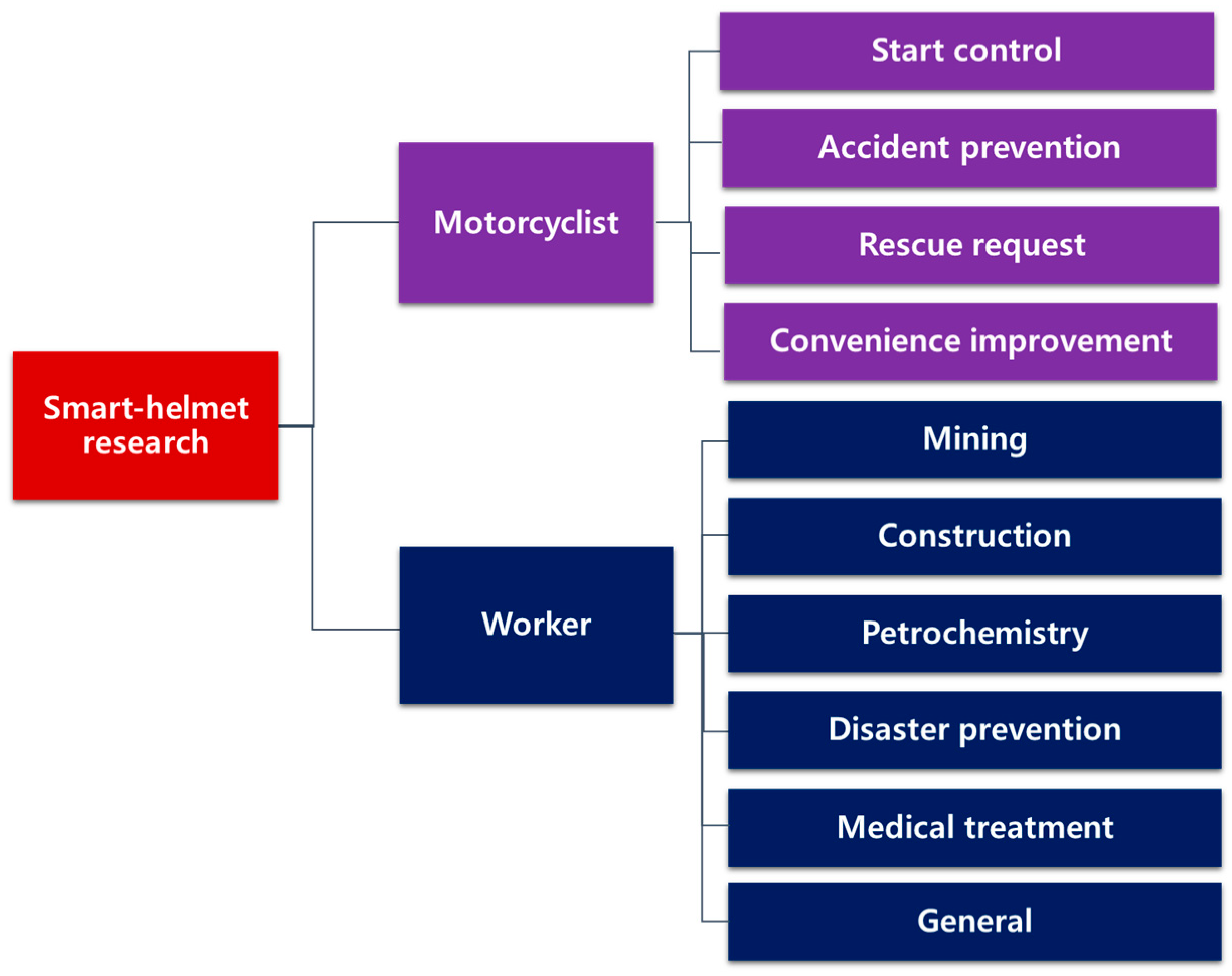
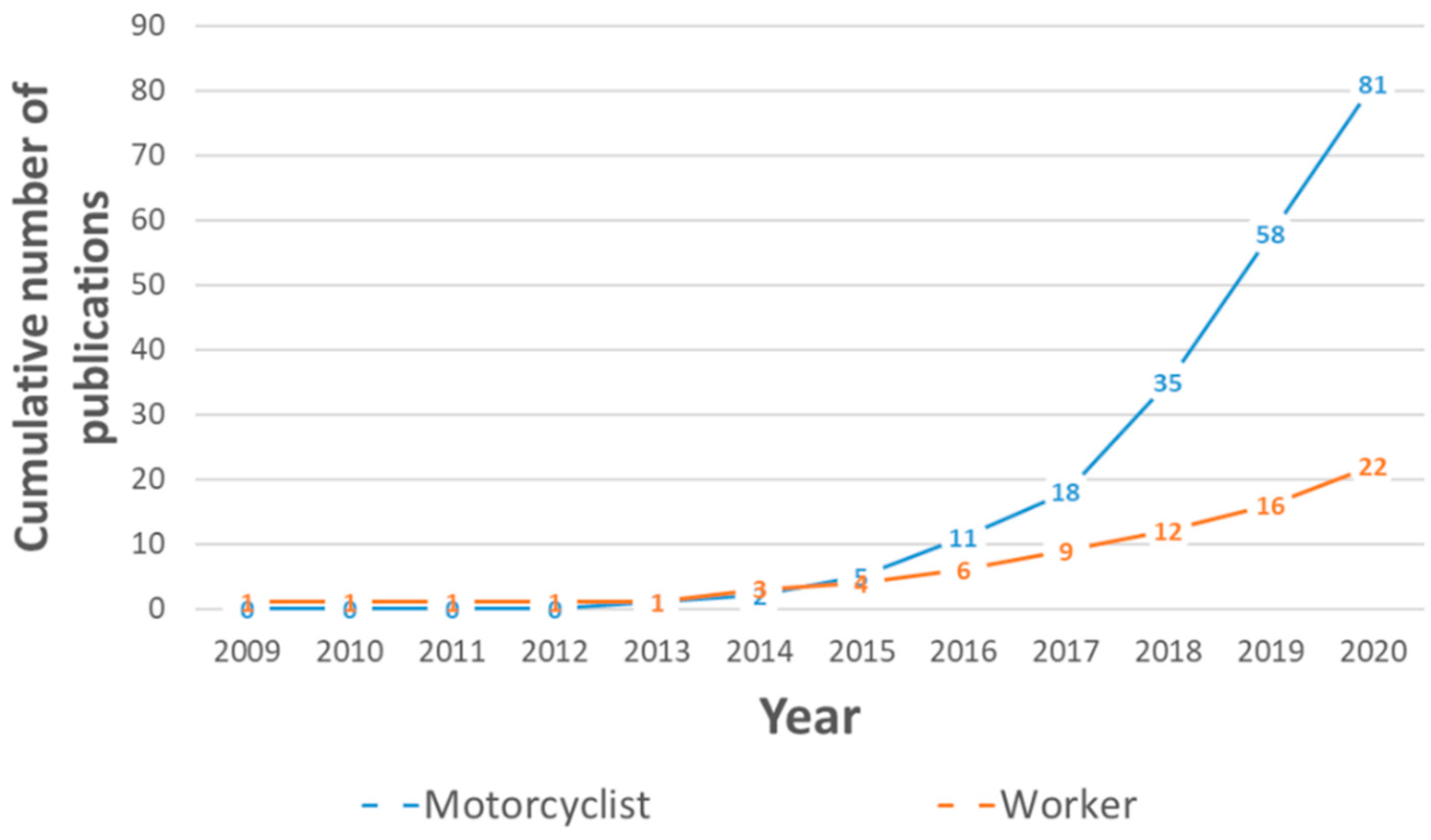
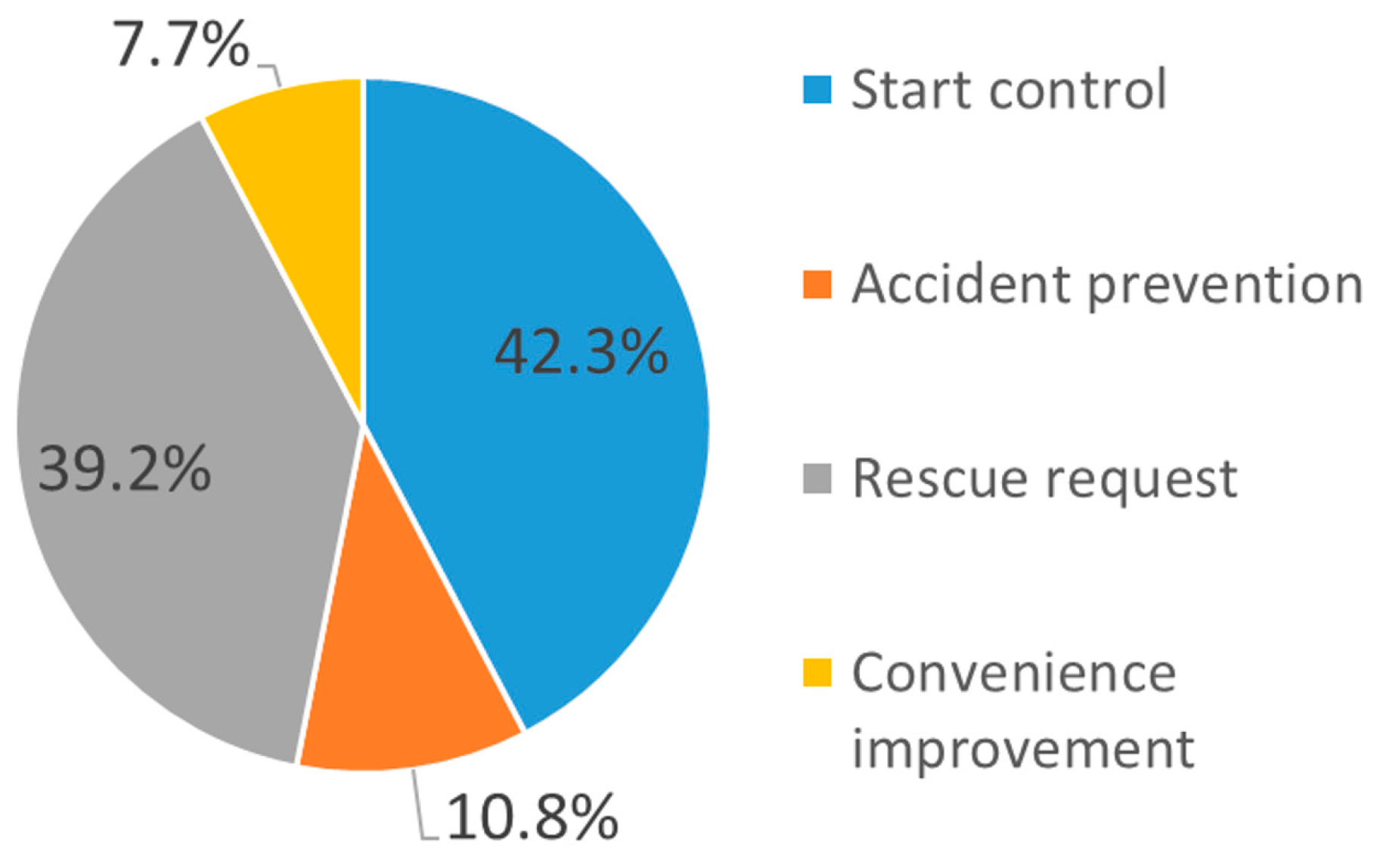
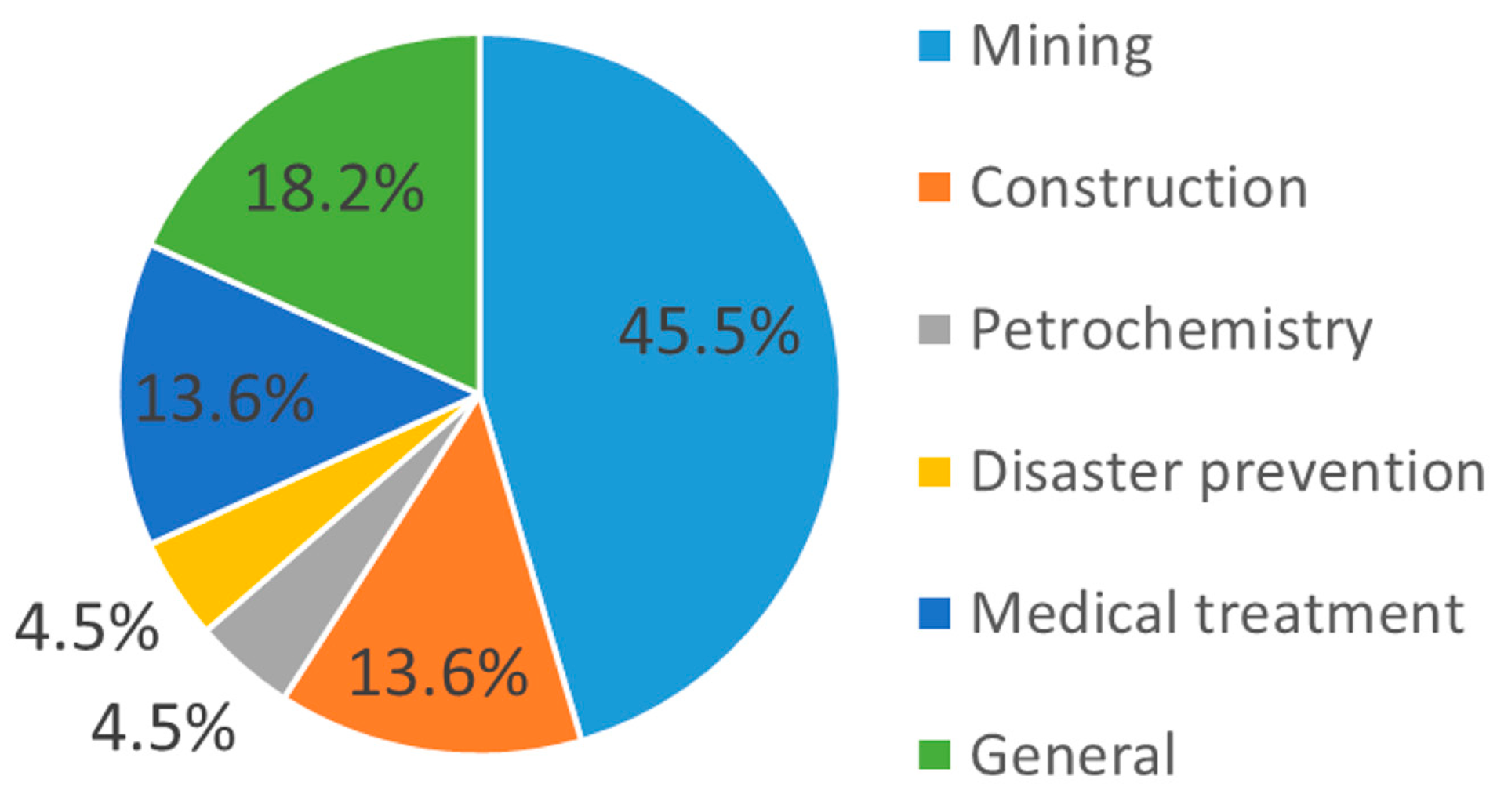
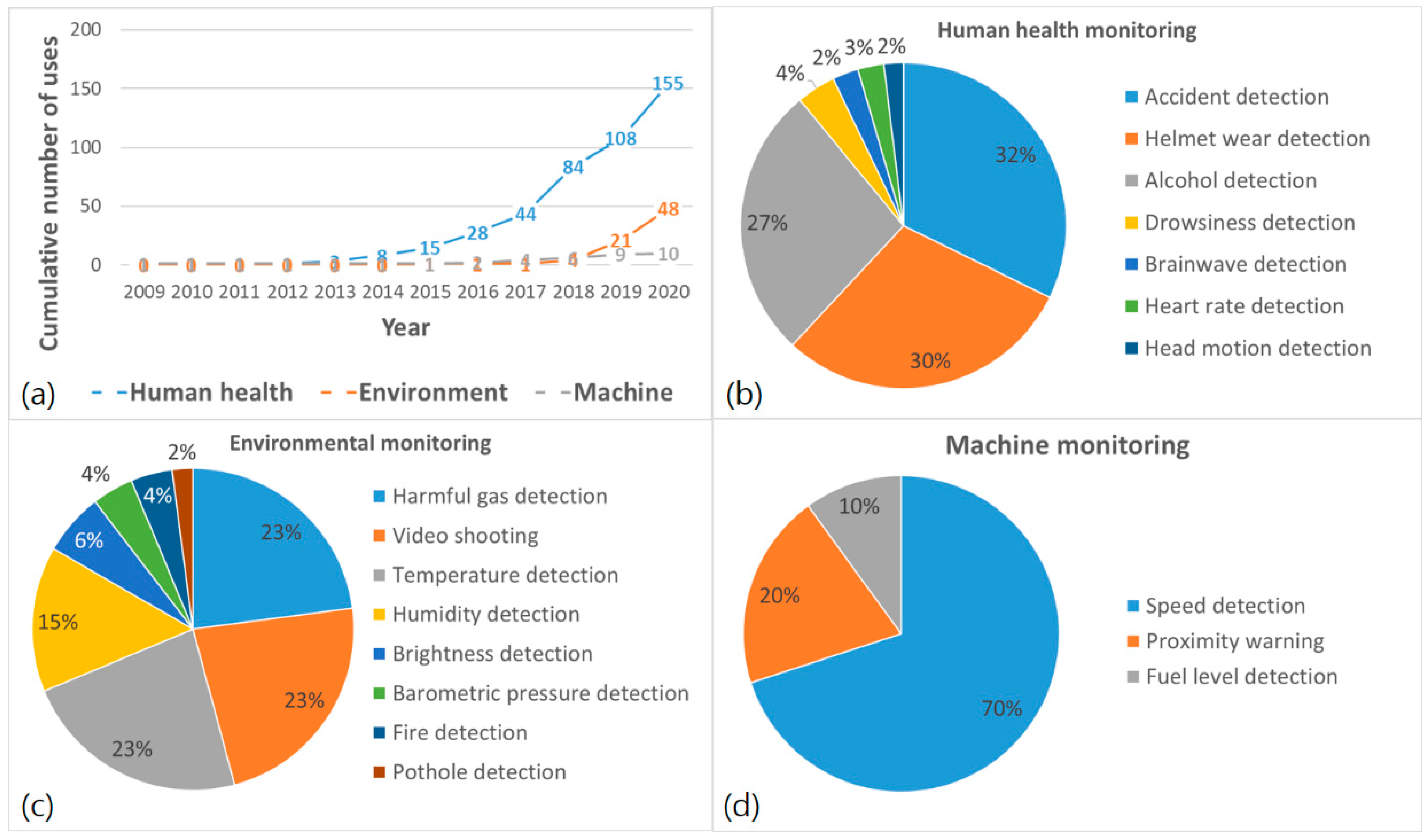
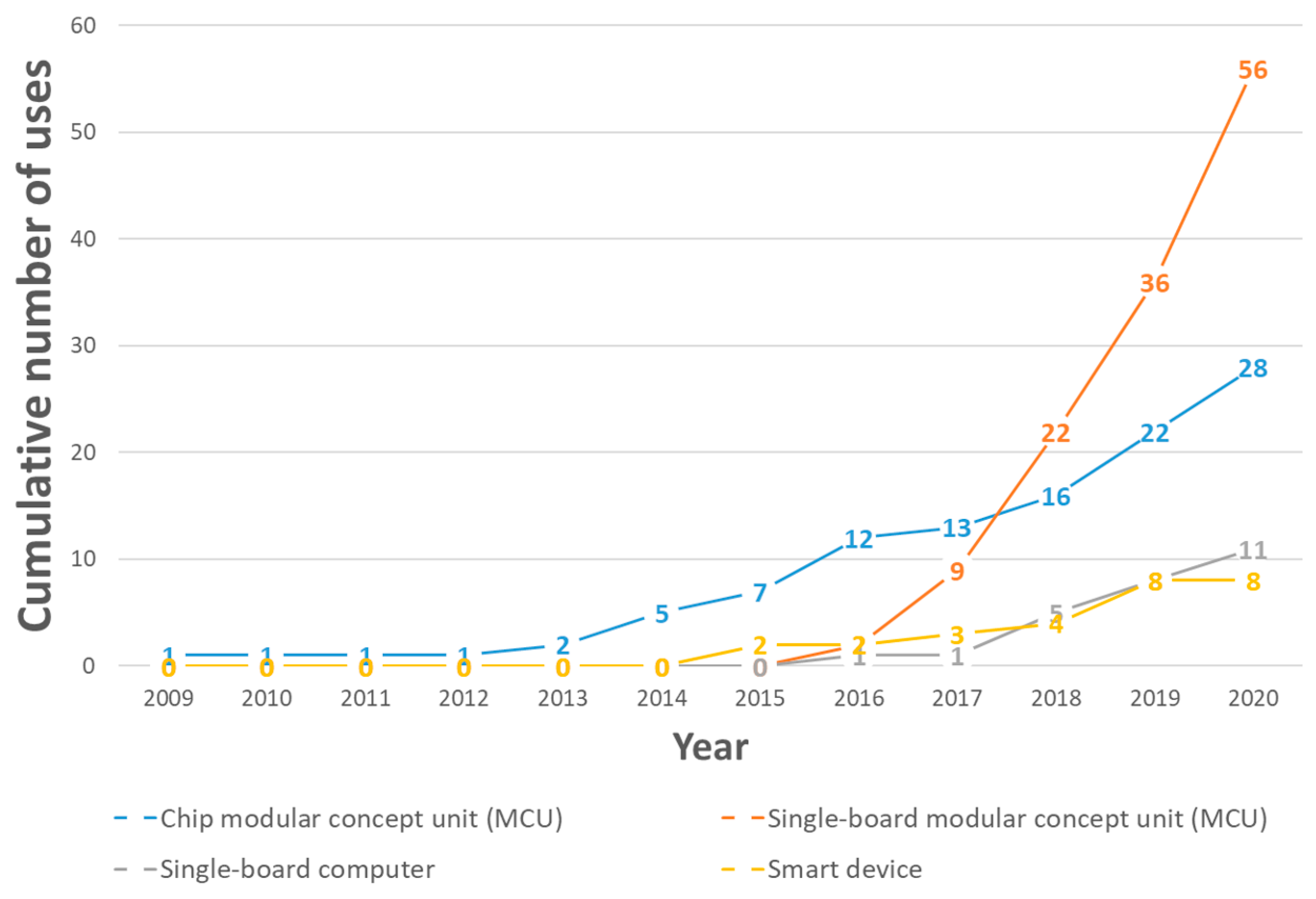
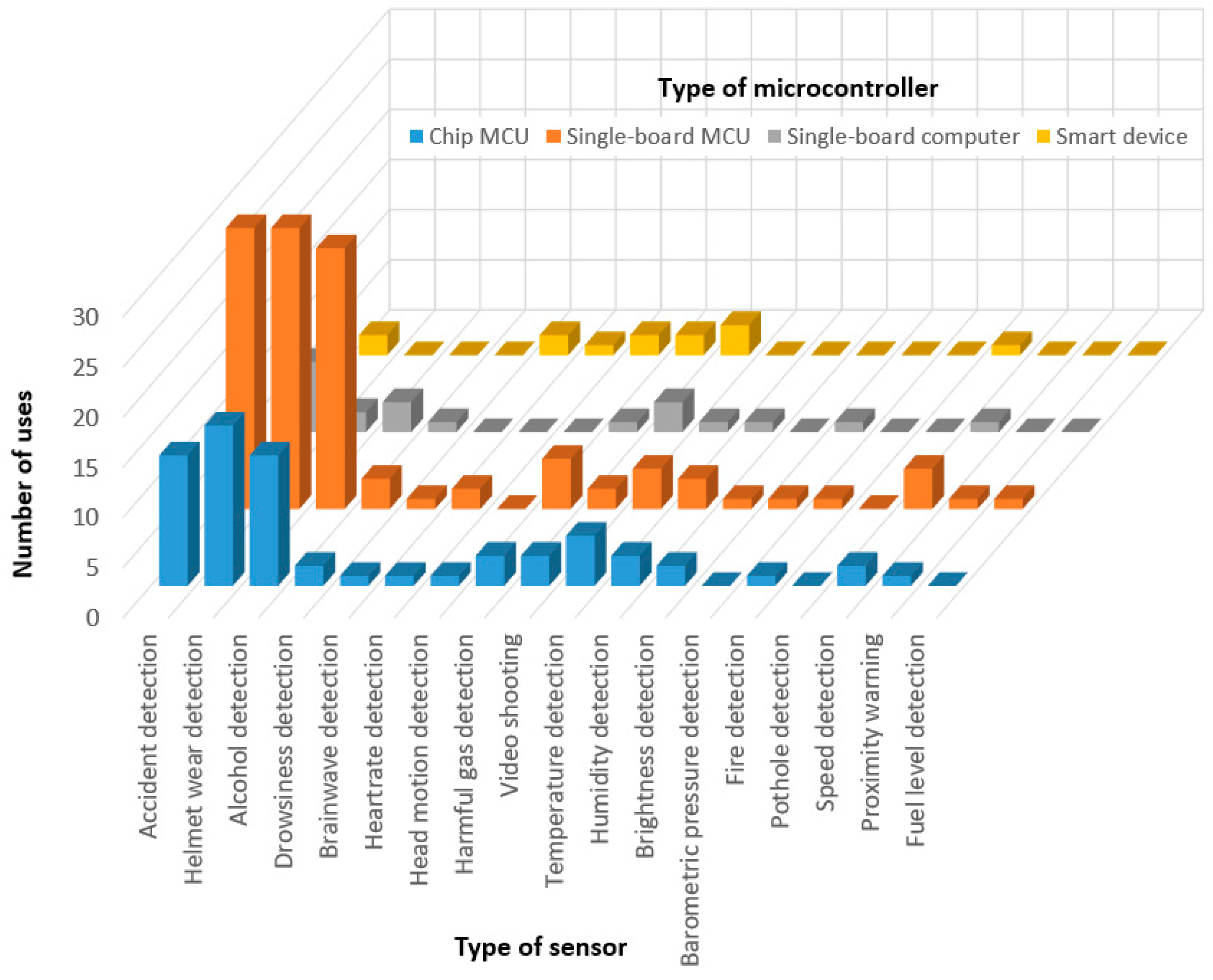
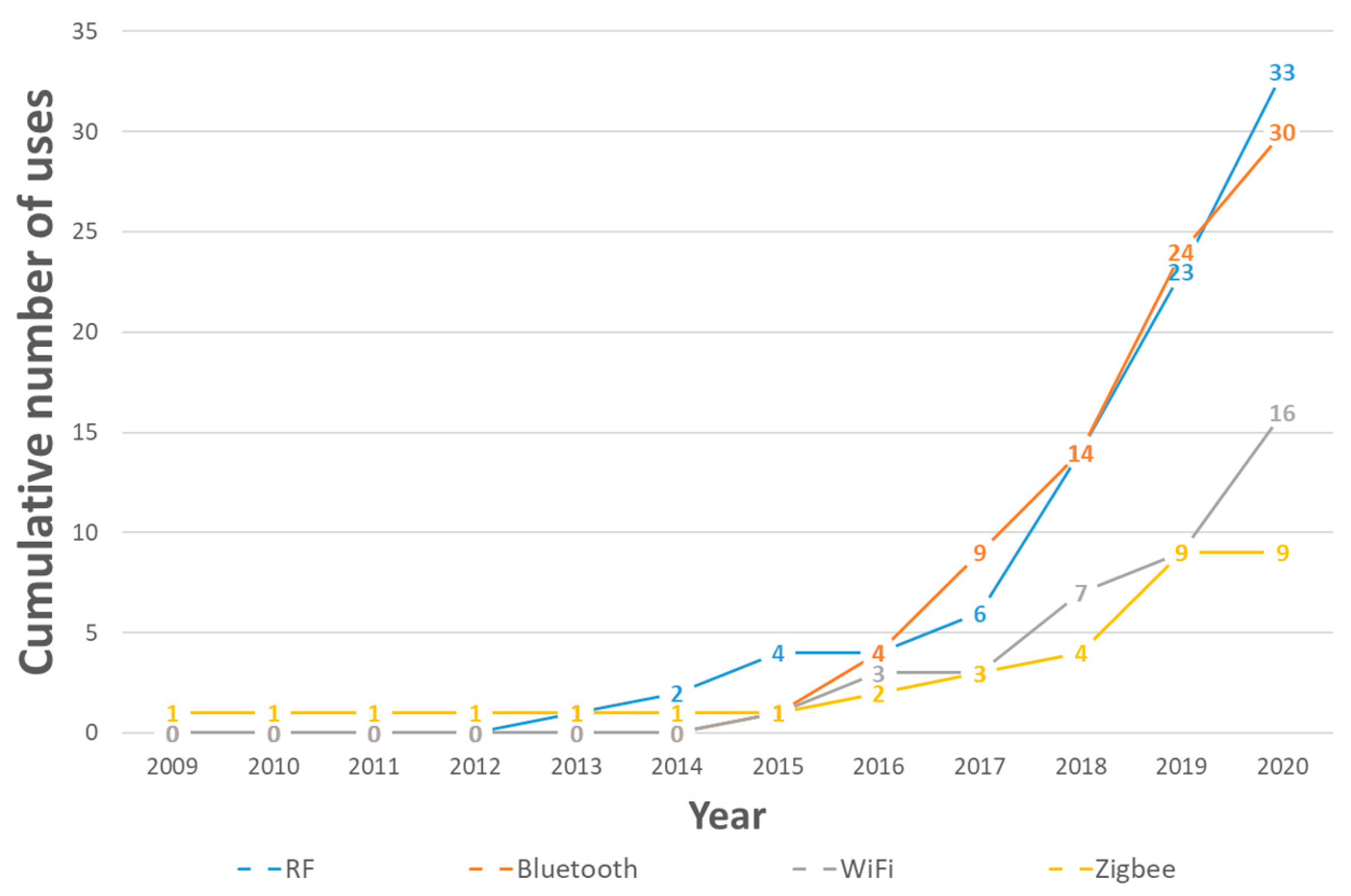
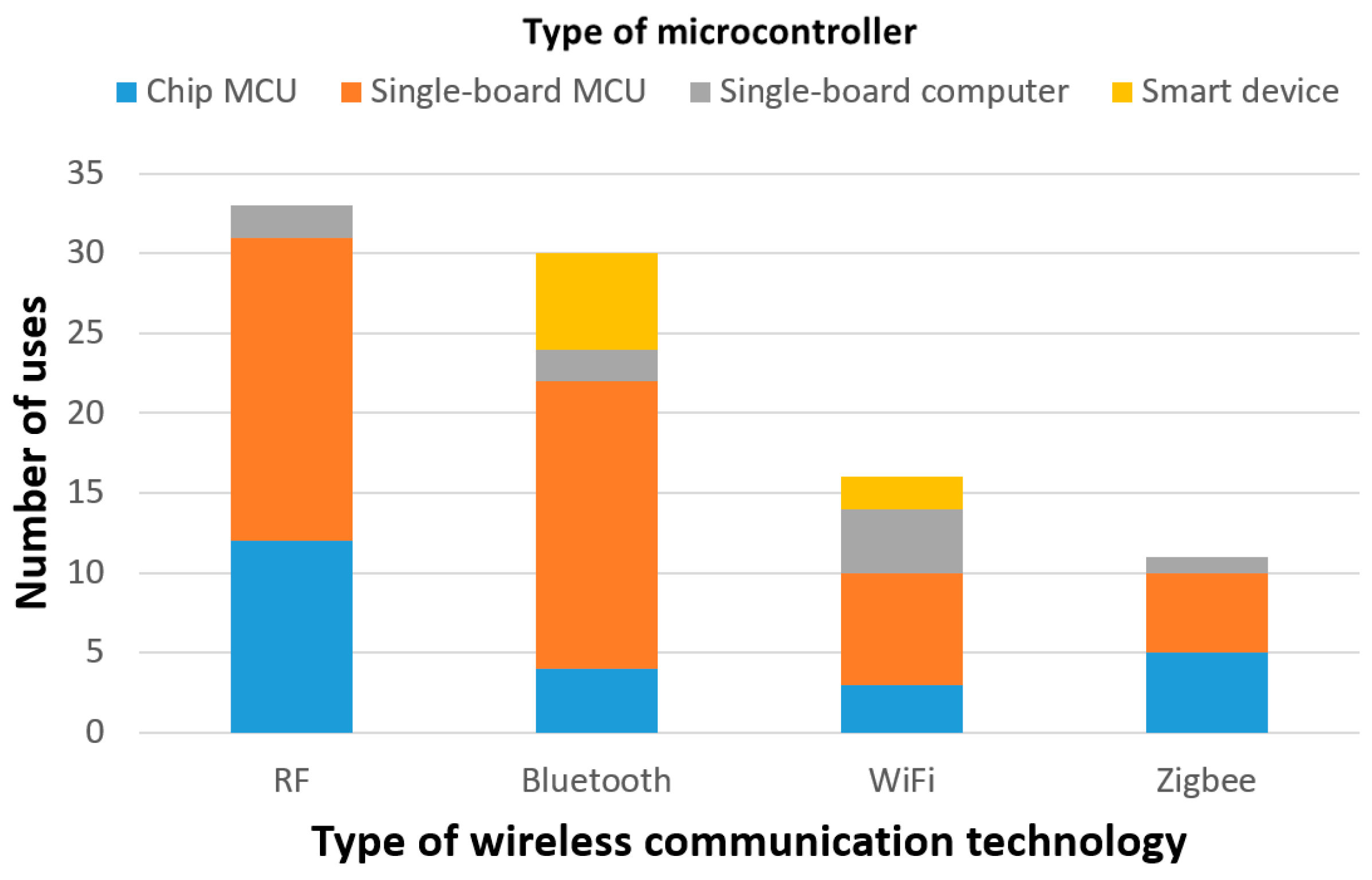
| Year | Application Field | Sensor | Microcontroller | Wireless Communication Technology | |
|---|---|---|---|---|---|
| 2009 2010 2011 2012 2013 2014 2015 2016 2017 2018 2019 2020 | Motorcyclist | - Start control - Accident prevention - Rescue request - Convenience improvement | - Human health - Environment - Machine | - Chip modular concept unit (MCU) - Single-board MCU - Single-board computer - Smart device | - Bluetooth - RF - Zigbee - WiFi |
| Worker | - Mining - Construction - Petrochemistry - Disaster prevention - Medical treatment - General | ||||
| Reference | Year | Feature and High-Level Functionality | Application (Sub-Category) | Sensor | Microcontroller | Wireless Technology |
|---|---|---|---|---|---|---|
| Singh et al. [7] | 2019 | Report potholes, collect air pollution data, and send it to a cloud server for analysis | Accident prevention | Porthole detection; Harmful gas detection | Smart device (Smartphone) | RF |
| Rasli et al. [10] | 2013 | Starts only when the helmet buckle is engaged, and warning is sent through the LED when over-speeding | Start control; Accident prevention | Helmet wear detection; Speed detection | Chip MCU (PIC) | RF |
| Vijayan et al. [11] | 2014 | Start-up management and accident prevention by collecting data on alcohol consumption and wearing a helmet | Start control | Alcohol detection; Helmet wear detection | Chip MCU (PIC) | RF |
| Agarwal et al. [12] | 2015 | Startup management by detecting whether a helmet is worn | Start control | Helmet wear detection | Chip MCU (Intel8051) | RF |
| Gautam et al. [13] | 2015 | Detects whether a helmet is worn or alcohol is consumed, and when both conditions are met, the engine starts up. Else, a text message is sent to a designated number when one of the conditions is not met or when an accident is detected | Start control; Rescue request | Helmet wear detection; Alcohol detection; Accident detection | Chip MCU (AT89S52) | RF |
| Melcher et al. [14] | 2015 | Collect vital signs to check the driver’s condition and request rescue by phone or text in case of an emergency | Rescue request | Vital Sign detection | Smart device (Smartphone) | Bluetooth |
| Chandran et al. [15] | 2016 | Detects an accident and connects to the cloud server via WiFi; requests rescue from the emergency contact network | Rescue request | Accident detection | Chip MCU (CC3200) | WiFi |
| Magno et al. [16] | 2016 | Situational awareness, blinking, drinking, and temperature data are collected to ensure driver safety; low power modules allow the system to run for a long time | Accident prevention | Eye blink detection; Alcohol detection; Temperature detection | Chip MCU (MSP432) | RF |
| Nikharge et al. [17] | 2016 | Raspberry Pi image processing detects whether a helmet is worn | Start control | Helmet wear detection | Single board computer (Raspberry Pi) | |
| Jadhawar et al. [18] | 2016 | Detects whether a helmet is worn and drinking alcohol, and when both conditions are satisfied, the engine is started, and an accident is detected through a fall detection and a text message is sent to request rescue | Start control; Rescue request | Helmet wear detection; Alcohol detection; Accident detection | Chip MCU (ATMEGA32) | |
| Kim et al. [19] | 2016 | Rescue request by detecting an accident and sending a text message to the registered number | Rescue request | Accident detection | Single board MCU (Arduino) | Bluetooth |
| Kumar et al. [20] | 2016 | Detects whether a helmet is worn and alcohol is consumed. When both conditions are met, the engine is started, an accident is detected, and connection is made to the cloud server to request rescue through a mobile phone app. | Start control; Rescue request | Alcohol detection; Accident detection; Helmet wear detection | Single board MCU (Arduino) | WiFi |
| Vashisth et al. [21] | 2017 | Detects whether the helmet is worn and if the driver is speeding in an inebriated state; if so, a text message is sent to request rescue in the event of an accident | Start control; Accident prevention; Rescue request | Helmet wear detection; Speed detection; Alcohol detection | Single board MCU (Arduino) | RF |
| Varade et al. [22] | 2017 | Detects whether the helmet is worn, sends the acceleration value to the cloud server for analysis, and requests rescue via text in case of an accident | Start control; Rescue request | Helmet wear detection | Chip MCU (ATMEGA16) | Bluetooth |
| Rajput et al. [23] | 2017 | Detects alcohol consumption, manages the start-up through fingerprint recognition, and sends a text message to the vehicle owner when the vehicle is stolen. | Start control | Alcohol detection | Single board MCU (Arduino) | |
| Patel et al. [24] | 2017 | Start-up management based on whether a helmet is worn, and an accident is detected and a text message is sent. | Start control; Rescue request | Helmet wear detection; Accident detection | Single board MCU (Arduino) | Bluetooth |
| Muthiah et al. [25] | 2017 | Introduction of autonomous headlight technology | Convenience improvement | Single board MCU (Arduino) | RF | |
| Ahuja and Bhavsar [26] | 2018 | Vibration and shake sensors detect accidents and send voice messages and texts when they occur | Rescue request | Accident detection | Single board MCU (Arduino) | |
| Godwani et al. [27] | 2018 | Detects people’s actions and shocks and sends text messages to family and acquaintances in case of an accident | Rescue request | Accident detection | Single board computer (Raspberry Pi) | WiFi |
| Parameshwari et al. [28] | 2018 | Detects whether a helmet is worn or drinking alcohol, and when both conditions are met, the engine starts up and a text message is sent in case of an accident. | Start control; Rescue request | Helmet wear detection; Alcohol detection; Accident detection | Single board MCU (Arduino) | Bluetooth |
| Biswas et al. [29] | 2018 | Detects an incident and sends an alert to nearby hospitals and other authorities by an app on your mobile phone connected to Google Firebase, which can be stopped via a PIN number | Rescue request | Accident detection | Single board computer (Raspberry Pi) | Bluetooth |
| Budiman et al. [30] | 2018 | Detect whether a helmet is worn and over speeding | Start control; Accident prevention | Helmet wear detection; Speed detection | Single board MCU (Arduino) | |
| Uniyal et al. [31] | 2018 | Collects helmet wearing status, location, speeding, and collision data; sends it to the cloud server; and requests rescue from nearby emergency facilities in case of an accident | Start control; Accident prevention; Rescue request | Helmet wear detection; Speed detection; Accident detection; Location detection | Single board MCU (Arduino) | RF |
| Paulchamy et al. [32] | 2018 | Detects whether a helmet is worn or alcohol is consumed; starts the engine when both conditions are met; collects location information; and sends text messages in case of an accident | Start control; Rescue request | Helmet wear detection; Alcohol detection; Accident detection | Single board MCU (Arduino) | RF |
| Souza and Maliyackal [33] | 2018 | Start management by detecting whether a helmet is worn | Start control | Helmet wear detection | Single board MCU (Arduino) | RF |
| Nanda et al. [34] | 2018 | Collecting data, such as alcohol consumption, driver’s license, blinking eyes, vibration, collision red light, etc. | Start control; Accident prevention; Rescue request | Alcohol detection; Driver’s license detection; Eye blink detection; Accident detection | Single board computer (Raspberry Pi) | RF |
| Deva et al. [35] | 2018 | Start management by detecting whether a helmet is worn | Start control | Helmet wear detection | Chip MCU (ATMEGA16) | Bluetooth |
| Sumamah et al. [36] | 2018 | Detects an accident and send a text message in the event of an accident | Rescue request | Accident detection | Single board MCU (Arduino) | |
| Shabbeer and Meleet [37] | 2018 | Detects an accident, marks the location on the map, and sends a text message | Rescue request | Accident detection | Single board MCU (Arduino) | WiFi |
| Gudavalli et al. [38] | 2018 | By recognizing the RFID tag, it locks and unlocks to ensure security, and detects whether a helmet is worn to manage the boot | Start control | Helmet wear detection | Single board MCU (Arduino) | RF |
| Tapadar et al. [39] | 2018 | Detects alcohol consumption, helmet-wearing status, and accidents; collects data; learns it by machine learning with the SVM model; and then measures the accuracy | Start control; Rescue request | Alcohol detection; Helmet wear detection; Accident detection | Single board MCU (Arduino) | Bluetooth |
| Premalatha and Nandhini [40] | 2018 | Detects drinking and accidents and sends text messages in case of accidents | Start control; Rescue request | Alcohol detection; Accident detection | Chip MCU (PIC) | RF |
| Dhulavvagol et al. [41] | 2018 | Detects drinking and accidents and sends text messages in case of accidents | Start control; Rescue request | Alcohol detection; Accident detection | Single board MCU (Arduino) | WiFi |
| Joshi and Joshi [42] | 2019 | Start-up management by collecting data on drinking, speeding, and wearing a helmet | Start control; Accident prevention | Alcohol detection; Speed detection; Helmet wear detection | Chip MCU (PIC) | RF |
| Namayala [43] | 2019 | Start-up management by collecting data on drinking alcohol and wearing a helmet | Start control | Alcohol detection; Helmet wear detection | Single board MCU (Arduino) | RF |
| Wong et al. [44] | 2019 | Collect and analyze data on driver’s head movement | Accident prevention | Head motion detection | Smart device (Smartphone) | |
| Kinage and Patil [45] | 2019 | Drinking and speeding are prevented, and drowsiness detection programs are applied through a webcam to prevent drowsy driving. | Start control; Accident prevention | Alcohol detection; Speed detection; Drowsiness detection | Single board MCU (Arduino) | |
| Swathi et al. [46] | 2019 | Start-up management by detecting alcohol consumption and helmet-wearing status, and ensures security with a password system | Start control | Alcohol detection; Helmet wear detection | Chip MCU (Atmega8) | RF |
| Reddy et al. [47] | 2019 | Detects alcohol consumption and helmet-wearing status, and sends a text message in case of an accident | Start control; Rescue request | Helmet wear detection; Alcohol detection; Accident detection | Single board MCU (Arduino) | ZigBee |
| Shravya et al. [48] | 2019 | Detects whether the helmet is worn, starts the engine, detects alcohol consumption, locks the engine, and transmits the vehicle number nearby via SMS text | Start control; Rescue request | Helmet wear detection; Alcohol detection; Accident detection | Single board MCU (Arduino) | RF |
| Kanimozhi et al. [49] | 2019 | Start-up management by detecting whether a helmet is worn, alcohol is consumed, and heart rate is normal | Start control | Helmet wear detection; Alcohol detection; Heart rate detection | Single board MCU (Arduino) | RF |
| Patil et al. [50] | 2019 | Detects whether the helmet is worn, locks it, and detects an accident by detecting a fall; sends this information via text to the registered number | Start control; Rescue request | Helmet wear detection; Accident detection | Chip MCU (Atmega88p) | RF |
| Jesudoss et al. [51] | 2019 | Detects whether a helmet is worn and alcohol is consumed, and starts the engine when both conditions are met. | Start control | Helmet wear detection; Alcohol detection | Chip MCU (PIC) | ZigBee |
| Kabilan et al. [52] | 2019 | Vibration sensor detects an accident and sends a text message to the location of the accident | Rescue request | Accident detection | Single board computer (Raspberry Pi) | WiFi |
| Ashwin and Yashwanth Gowda [53] | 2019 | Detects whether a helmet is worn and drinking alcohol, and when both conditions are met, the engine is started and a text message is sent in case of an accident | Start control; Rescue request | Helmet wear detection; Alcohol detection; Accident detection | Chip MCU (Atmega32) | RF |
| Chen et al. [54] | 2019 | Collision detection by analyzing driver’s head motion | Rescue request | Head motion detection | Smart device (Smartphone) | Bluetooth |
| Gupta et al. [55] | 2019 | Detects collision and drinking, requests rescue through text messages in case of an accident, and acts as a black box through a camera module | Start control; Rescue request | Alcohol detection; Accident detection | Single board computer (Raspberry Pi) | Bluetooth |
| Priya et al. [56] | 2019 | Detects whether a helmet is worn, manages the boot, detects an accident with vibration, and sends a text message | Start control; Rescue request | Helmet wear detection; Accident detection | Chip MCU (PIC) | RF |
| Vijayakumar et al. [57] | 2019 | Detects whether a helmet is worn and drinking, and notifies the driver of the presence of nearby vehicles through motion detection | Start control; Accident prevention | Helmet wear detection; Alcohol detection; Motion detection | Single board MCU (Arduino) | RF |
| Divyasudha et al. [58] | 2019 | Accident, location, and alcohol are detected and sent to the cloud server for analysis | Start control; Rescue request | Alcohol detection; Alcohol detection; Location detection | Single board MCU (Arduino) | ZigBee |
| Mhatre et al. [59] | 2020 | Detects whether a helmet is worn and drinking alcohol, and when both conditions are met, the engine starts and a text message is sent to the designated number in case of an accident | Start control; Rescue request | Helmet wear detection; Alcohol detection; Accident detection | Single board MCU (Arduino) | RF |
| Lakshmanachari et al. [60] | 2020 | Detects whether a helmet is worn, drinking, or speeding, and sends a text message in case of an accident | Start control; Rescue request | Helmet wear detection; Alcohol detection; Speed detection; Accident detection | Chip MCU (ARM7) | RF |
| Merlin and Pranay [61] | 2020 | Detects whether the helmet is worn and sounds the buzzer until the helmet is worn | Start control | Helmet wear detection | Single board MCU (Arduino) | RF |
| Chidambarathanu et al. [62] | 2020 | Collects brainwave and drinking data and sends location information via text in case of an accident | Start control; Rescue request | Brainwave detection; Alcohol detection; Accident detection | Single board MCU (Arduino) | Bluetooth |
| Santhanakrishnan et al. [63] | 2020 | Detects whether or not to wear a helmet and drinking alcohol, and when both conditions are met, the engine is started and location information is sent by text in case of an accident | Start control; Rescue request | Helmet wear detection; Alcohol detection; Accident detection; Location detection | Single board MCU (Arduino) | RF |
| Sai Kumar and Aruna [64] | 2020 | Detects whether a helmet is worn, and when not wearing a message, a message is displayed through the LCD, and a text message is sent to detect alcohol and accidents | Start control; Rescue request | Helmet wear detection; Alcohol detection; Accident detection | Chip MCU (PIC) | ZigBee |
| Suman et al. [65] | 2020 | Detects drinking alcohol and wearing a helmet and sends a text message in case of an accident | Start control; Rescue request | Alcohol detection; Helmet wear detection; Accident detection | Chip MCU (TICC2200) | WiFi |
| Ahmed et al. [66] | 2020 | Detects objects, detects danger, and sends text messages in case of an accident | Rescue request | Object detection; accident detection | Single board computer (Raspberry Pi) | WiFi |
| Dubey et al. [67] | 2020 | Detects whether a helmet is worn; monitors road conditions to help change lanes; and sends a text message in case of an accident | Start control; Rescue request | Helmet wear detection; Accident detection | Single board MCU (Arduino) | |
| Lokeshwaran et al. [68] | 2020 | Detect wearing a helmet, measures your heart rate, and makes a call in case of an accident | Start control; Rescue request | Helmet wear detection; Accident detection; Heart rate detection | Single board MCU (NODEMCU) | RF |
| Rahman et al. [69] | 2020 | Detects drinking and wearing a helmet, stores location information, and transmits location information in case of an accident | Start control; Rescue request | Helmet wear detection; Alcohol detection; Accident detection; Location detection | Single board MCU (Arduino) | Bluetooth |
| Faikul et al. [70] | 2020 | Prevents drowsy driving by detecting heart rate | Accident prevention | Heart rate detection | Single board MCU (Arduino) | |
| Rao et al. [71] | 2020 | Detects wearing of a helmet and drinking, manages the start-up, and sends location information via text message | Start control; Rescue request | Helmet wear detection; Alcohol detection; Accident detection; Location detection | Single board MCU (Arduino) | WiFi |
| Oviyaa et al. [72] | 2020 | Brainwave is measured to detect drowsiness and fatigue and give a warning | Accident prevention | Brainwave detection | Single board MCU (Arduino) | Bluetooth |
| Shahare et al. [73] | 2020 | Detects wearing a helmet, manages the start-up, detects alcohol consumption and accidents, and sends location information by text in case of an accident | Start control; Rescue request | Helmet wear detection, Alcohol detection; Accident detection; Location detection | Single board MCU (Arduino) | RF |
| Ashwini et al. [74] | 2020 | Detects wearing a helmet, manages the start-up, detects drinking and accidents, and sends location information by text in case of an accident | Start control; Rescue request | Helmet wear detection; Alcohol detection; Accident detection; Location detection | Single board MCU (Arduino) | RF |
| Jayasinghe and Arachchige [75] | 2020 | Detects alcohol and drowsiness and manages start-up | Start control; Accident prevention; Rescue request | Alcohol detection; Drowsiness detection | Single board MCU (Arduino) | Bluetooth |
| Aravinda et al. [76] | 2020 | Detects wearing a helmet and manages the start-up | Start control | Helmet wear detection | Single board computer (Raspberry Pi) | RF |
| MohanaRoopa et al. [77] | 2020 | Start management by detecting drinking, wearing a helmet, and sending location information by text in case of an accident | Start control; Rescue request | Helmet wear detection; Alcohol detection; Accident detection; Location detection | Single board MCU (Arduino) | WiFi |
| Pothirajan and Mary [78] | 2020 | Detects drinking and wearing a helmet | Start control | Helmet wear detection; Alcohol detection | Single board MCU (Arduino) | RF |
| Swarna et al. [79] | 2020 | Detects alcohol and manages the start-up and sends location information via text message in case of an accident | Start control; Rescue request | Alcohol detection; Location detection | Single board MCU (Arduino) | RF |
| Parakkal et al. [80] | 2020 | Detects speeding and sends location information via text in case of an accident | Start control; Accident prevention; Rescue request | Speed detection; Location detection | Single board computer (Raspberry Pi) | WiFi |
| Kumar Kar et al. [81] | 2018 | Convenience is provided through systems such as headlights and audio | Convenience improvement | Location detection | Single board MCU (Arduino) | Bluetooth |
| Rahman et al. [82] | 2019 | Detect fuel level and notify through notification system | Convenience improvement | Fuel level detection | Single board MCU (Arduino) | Bluetooth |
| Jadhav et al. [83] | 2019 | Provides convenience, such as navigation, traffic conditions, music, and phone calls, through voice recognition on the HUD by connecting a mobile phone | Convenience improvement | Location detection | Single board MCU (Arduino) | Bluetooth |
| Youssef et al. [84] | 2019 | Provides thermal comfort when wearing a helmet | Convenience improvement | Humidity detection; Temperature detection | Single board MCU (Arduino) | Bluetooth |
| Rao [85] | 2019 | A system that can operate the helmet wiper through voice recognition | Convenience improvement | N/A | Single board MCU (Arduino) | Wifi |
| Kanetkar et al. [86] | 2020 | Detects raindrops and automatically controls the helmet’s wiper | Convenience improvement | Rain detection | Single board MCU (Arduino) | N/A |
| Astif and Manoj [87] | 2017 | Convenience such as navigation and listening to music is provided, and a text message is sent by pressing a button in case of an accident | Rescue request; Convenience improvement | Location detection | Single board MCU (Arduino) | Bluetooth |
| Ajay et al. [88] | 2017 | Provides convenience functions while driving and voice calls in case of an accident | Rescue request; Convenience improvement | Accident detection | Single board MCU (Arduino) | Bluetooth |
| Kumar et al. [89] | 2019 | By connecting to a mobile phone, it provides convenience, such as phone calls, navigation, and listening to music, and detects alcohol consumption | Rescue request; Convenience improvement | Alcohol detection | Single board MCU (Arduino) | Bluetooth |
| Reference | Year | Feature and High-Level Functionality | Application (Sub-Category) | Sensor | Microcontroller | Wireless Technology |
|---|---|---|---|---|---|---|
| Wang et al. [8] | 2020 | Detects stair fall by analyzing changes in weight support and pressure center | Construction | Accident detection | Single board MCU (Arduino) | Bluetooth |
| Mohammed et al. [9] | 2020 | Helps prevent the spread of coronavirus by measuring the body temperature and personal information of pedestrians | Medical treatment | Temperature detection | Single board MCU (Arduino) | Bluetooth |
| Qiang et al. [90] | 2009 | Real-time monitoring of methane, temperature and humidity data and support for voice communication between operators | Mining | Harmful gas detection; Humidity detection; Temperature detection | Chip MCU (S3C44BOX) | ZigBee |
| Shabina [91] | 2014 | Transmits real-time temperature, humidity, and fire data through a wireless network and alerts the operator by sounding an alarm when the threshold is reached | Mining | Temperature detection; Humidity detection; Fire detection | Chip MCU (AT89S52) | N/A |
| Behr et al. [92] | 2016 | Collects data on the concentration of harmful gases, whether the helmet is worn, and the amount of impact on the helmet, and transmits and analyzes it to the cloud server | Mining | Harmful gas detection; Helmet wear detection | Chip MCU (ATZB-24-A2) | ZigBee |
| Hazarika [93] | 2017 | Measures the concentration of harmful gas and sends it to the cloud server for real-time monitoring and alarms in the control room when the threshold is exceeded | Mining | Harmful gas detection | Single board MCU (Arduino) | ZigBee |
| Sharma and Maity [94] | 2018 | Measures the concentration of harmful gases, temperature, and humidity, sends them to the cloud server for real-time monitoring, and sounds an alarm when the threshold is exceeded | Mining | Harmful gas detection; Temperature detection; Humidity detection | Single board MCU (Arduino) | ZigBee |
| Revindran et al. [95] | 2018 | A wireless sensor network was built and rescue request was from nearby workers and medical teams when workers send distress messages | Mining | Accident detection | Chip MCU (Arduino) | RF |
| Eldemerdash et al. [96] | 2019 | Temperature and humidity, harmful gas concentration, and pressure data are monitored, and when thresholds are reached, warnings are sent through LEDs and buzzers | Mining | Temperature detection; Humidity detection; Harmful gas detection | Single board computer (Raspberry Pi) | ZigBee |
| Sanjay et al. [97] | 2019 | Temperature and humidity, harmful gas concentration, and pressure data are monitored, and when thresholds are reached, warnings are made through LEDs and buzzers | Mining | Temperature detection; Humidity detection; Harmful gas detection | Single board MCU (Arduino) | ZigBee |
| Charde et al. [98] | 2020 | Collects harmful gas concentration, humidity, and temperature data to enable real-time monitoring and alerts through buzzer and LCD when hazardous concentrations are reached | Mining | Temperature detection; Humidity detection; Harmful gas detection | Chip MCU (PIC) | ZigBee |
| Sujitha et al. [99] | 2020 | Detects temperature and humidity, light intensity, toxic gas levels in the air, traces of flames, etc. and warns when thresholds are exceeded | Mining | Temperature and Humidity detection; Brightness detection; Harmful gas detection; Fire detection | Single board MCU (Arduino) | WiFi |
| Pirkl et al. [100] | 2016 | IR camera sensor measures the temperature of the surrounding environment | Construction | Temperature detection | Chip MCU (IntelEdison) | Bluetooth |
| Lee et al. [101] | 2019 | Detects falls, air quality, and objects fall and sends data to the cloud server for storage | Construction | Harmful gas detection; Accident detection | Single board MCU (Arduino) | Bluetooth |
| Li et al. [102] | 2014 | Inertia and brain waves are measured to analyze injury and fatigue, and vibration alerts when thresholds are exceeded | General | Brainwave detection; Motion detection | Chip MCU (PIC) | N/A |
| Dhingra et al. [103] | 2018 | Voice communication between workers is possible and rescue request through panic button in case of crisis | General | Accident detection | Single board MCU (Arduino) | RF |
| Aston et al. [104] | 2020 | Impulse quantity is dispersed | General | N/A | Chip MCU | N/A |
| Campero-Jurado et al. [105] | 2020 | Temperature and humidity, harmful gas concentration and brightness are detected and transmitted to a cloud server for analysis | General | Temperature and Humidity detection; Brightness detection; Harmful gas detection | Chip MCU (PIC) | WiFi |
| Shu et al. [106] | 2015 | Early warning in case of leakage of harmful gas | Petrochemistry | Harmful gas detection | Smart device (Smartwatch) | WiFi |
| Bisio et al. [107] | 2017 | Detects stroke in emergency patients | Medical treatment | Brainwave detection | Smart device (Smartphone) | Bluetooth |
| Shahiduzzaman et al. [108] | 2019 | Detects a fall, sends medical data to the medical cloud, and requests rescue | Medical treatment | Accident detection | Smart device (Smartphone) | Bluetooth |
| Jeong et al. [109] | 2018 | Infrared image, optical image, drone image, oxygen residual amount, inertia, etc. are collected | Disaster prevention | Harmful gas detection | Smart device (Smartwatch) | WiFi |
| Human Health Monitoring | Environmental Monitoring | Machine Monitoring |
|---|---|---|
| - Accident detection (50 papers) - Helmet wear detection (46 paper) - Alcohol detection (42 papers) - Drowsiness detection (6 papers) - Brainwave detection (4 papers) - Heart rate detection (4 papers) - Head motion detection (3 papers) | - Harmful gas detection (11 papers) - Video shooting (11 papers) - Temperature detection (11 papers) - Humidity detection (7 papers) - Brightness detection (3 papers) - Barometric pressure detection (2 papers) - Fire detection (2 papers) - Pothole detection (1 papers) | - Speed detection (7 papers) - Proximity warning (2 papers) - Fuel level detection (1 papers) |
Publisher’s Note: MDPI stays neutral with regard to jurisdictional claims in published maps and institutional affiliations. |
© 2021 by the authors. Licensee MDPI, Basel, Switzerland. This article is an open access article distributed under the terms and conditions of the Creative Commons Attribution (CC BY) license (https://creativecommons.org/licenses/by/4.0/).
Share and Cite
Choi, Y.; Kim, Y. Applications of Smart Helmet in Applied Sciences: A Systematic Review. Appl. Sci. 2021, 11, 5039. https://doi.org/10.3390/app11115039
Choi Y, Kim Y. Applications of Smart Helmet in Applied Sciences: A Systematic Review. Applied Sciences. 2021; 11(11):5039. https://doi.org/10.3390/app11115039
Chicago/Turabian StyleChoi, Yosoon, and Yeanjae Kim. 2021. "Applications of Smart Helmet in Applied Sciences: A Systematic Review" Applied Sciences 11, no. 11: 5039. https://doi.org/10.3390/app11115039
APA StyleChoi, Y., & Kim, Y. (2021). Applications of Smart Helmet in Applied Sciences: A Systematic Review. Applied Sciences, 11(11), 5039. https://doi.org/10.3390/app11115039







